Structural Styles and Dolomites Field Trip
2008, Memorie Descrittive della CARTA GEOLOGICA d’ITALIA vol. LXXXII
…
301 pages
1 file

Sign up for access to the world's latest research
Abstract
During the last 30 years, structural geology had relevant advances thanks to a wealth of data provided by geological and geophysical investigations. In this volume we propose a sort of handbook for basic tectonic features. We review the fundamental mechanics, and the most common features associated to brittle deformation. The main geometries and kinematics of compressional, transpressive, strike-slip, transtensive and extensional tectonic environments are presented. Moreover the migration of rupture along faults and the elementary evolution of diapirs are discussed. Few instances on how tectonics influences sedimentation, compaction, and the sedimentary architecture controls tectonics are highlighted. The structural features are then inserted in a wider geodynamic scenario in which the basic element is the basal decollement, with its depth, temperature, pressure and strain rate. The regional subsidence or uplift is combined with the growth rate of single tectonic features, which may locally increase or decrease the regional motions. This points to the computation for example of the fold total uplift, e.g., the uplift of an anticline minus the regional subsidence rate of the foredeep, that can even exceed the vertical growth rate of the fold. The combination with variable sedimentation rates may further differentiate the growth structures. The geodynamics of subduction zones and rift zones is discussed in the frame of the westward drift of the lithosphere, generating a worldwide asymmetry, which can be recognized as well as between the subduction zones in the Mediterranean realm. Unlike the Apennines, the Alps do not have a coaxial rifting in the hangingwall of the subduction, i.e., a back arc basin as the Tyrrhenian Sea. In this context, the Southern Alps and the Dolomites in particular, are rather the compressive retrobelt of the Alpine orogen, which is associated to the right-lateral transpressive subduction along the E-W trending segment of the belt. The Dolomites were undergoing rifting episodes during the Permo-Mesozoic. Fast subsidence rates during the Ladinian would support a backarc origin in the hangingwall of a W-directed subduction zone, possibly located in the present Pannonian Basin. The Dolomites are located half on the N-trending Trento Horst to the west, and the other half on the Belluno Graben to the east, both extensional features of Permo-Mesozoic age. The Trento Horst determined an undulation in the Alpine thrusting, being located in a recess since the early phases of shortening, generating left-lateral transpression along the western border (Giudicarie system), and right-lateral transpression on its eastern margin (Paleogene WSW-verging thrusts of the central-eastern Dolomites). The adjacent Lombard Graben (and basin) to the west, and the Belluno Basin to the east have rather been the seat of salients. The description of a five days field trip illustrates well exposed examples of tectonic features generated by the Mesozoic rifting and the later Cenozoic Alpine inversion that generated a classic thrust belt with imbricate fan geometry.
Figures (442)










![Fig. 9 - Generic Mohr diagram showing a composite Griffith- Coulomb failure envelope for intact rocks. The three shown cri- tical stress circles represent different failure modes: tensional fracturing, transitional-tensional fracturing (also called in lite- rature extensional-shear fracturing) and compressional failure (also called in literature compressional shear failure). Fig. 8 - Mohr diagram showing the state of effective stress at failure for various experiments (varying the confining and the axial load) with intact Fredrick Diabase. Each circle represents the state of stress at failure at a different mean stress ([o1+02+03]/3). The locus of stress states that bounds the field of stable and unstable stresses is called the Mohr envelo- pe (after Suppe, 1985).](https://figures.academia-assets.com/32635436/figure_011.jpg)















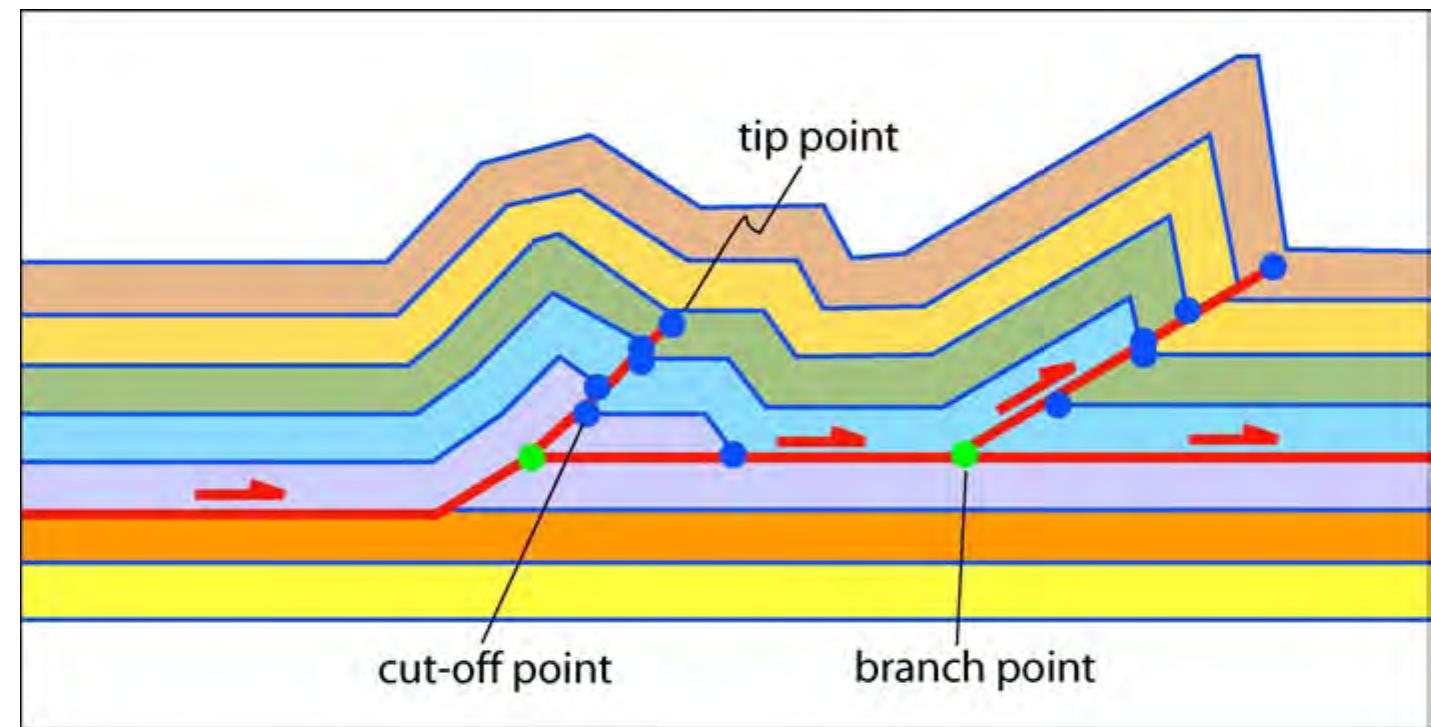





















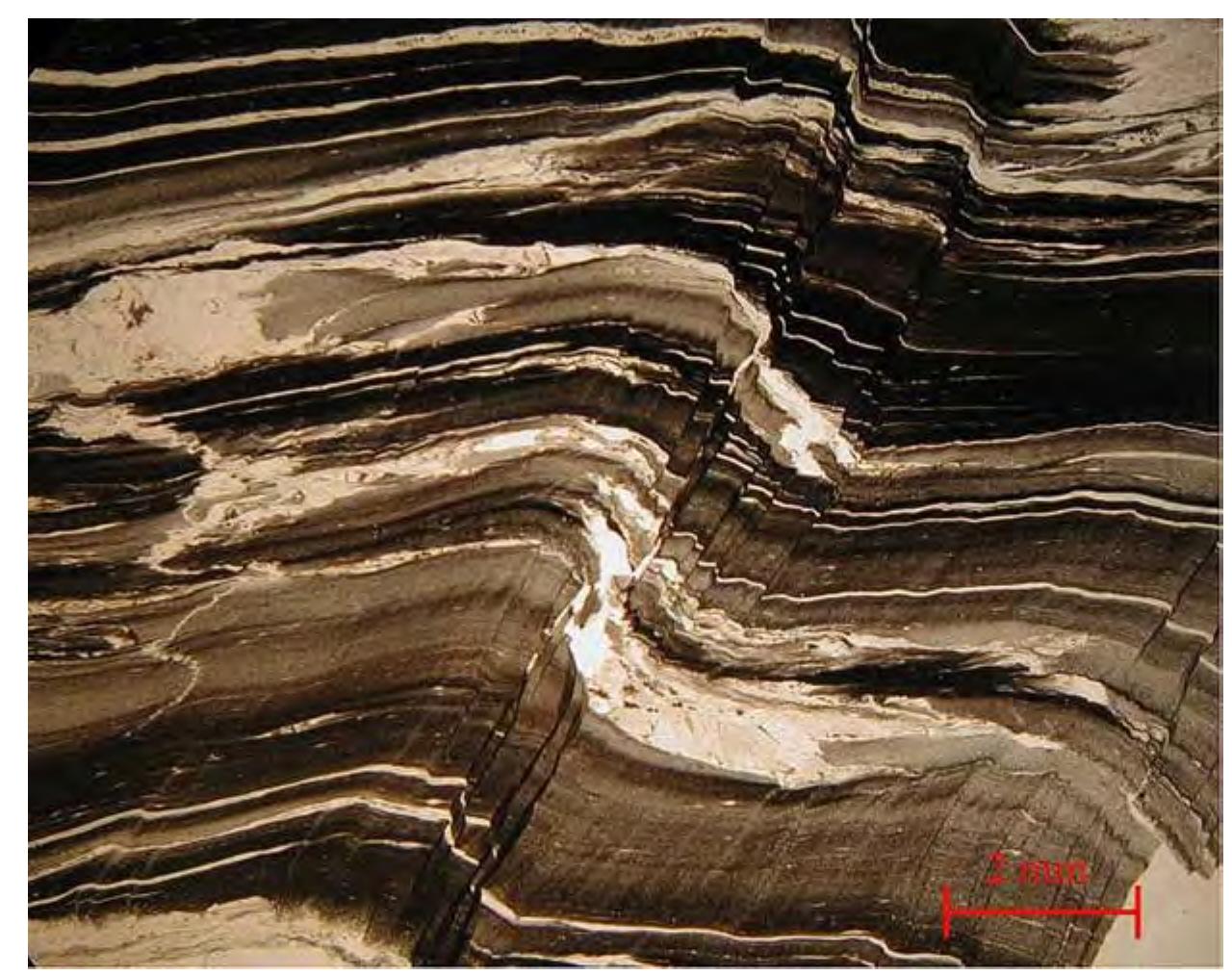




![Fig. 47 - The trishear model (ERSLEV, 1991, ALLMENDINGER, 1998) explains most of the deformation occurring at the tip line of faults. httn://www geo. cornell edu/RWA /trishear/default htm]](https://figures.academia-assets.com/32635436/figure_054.jpg)
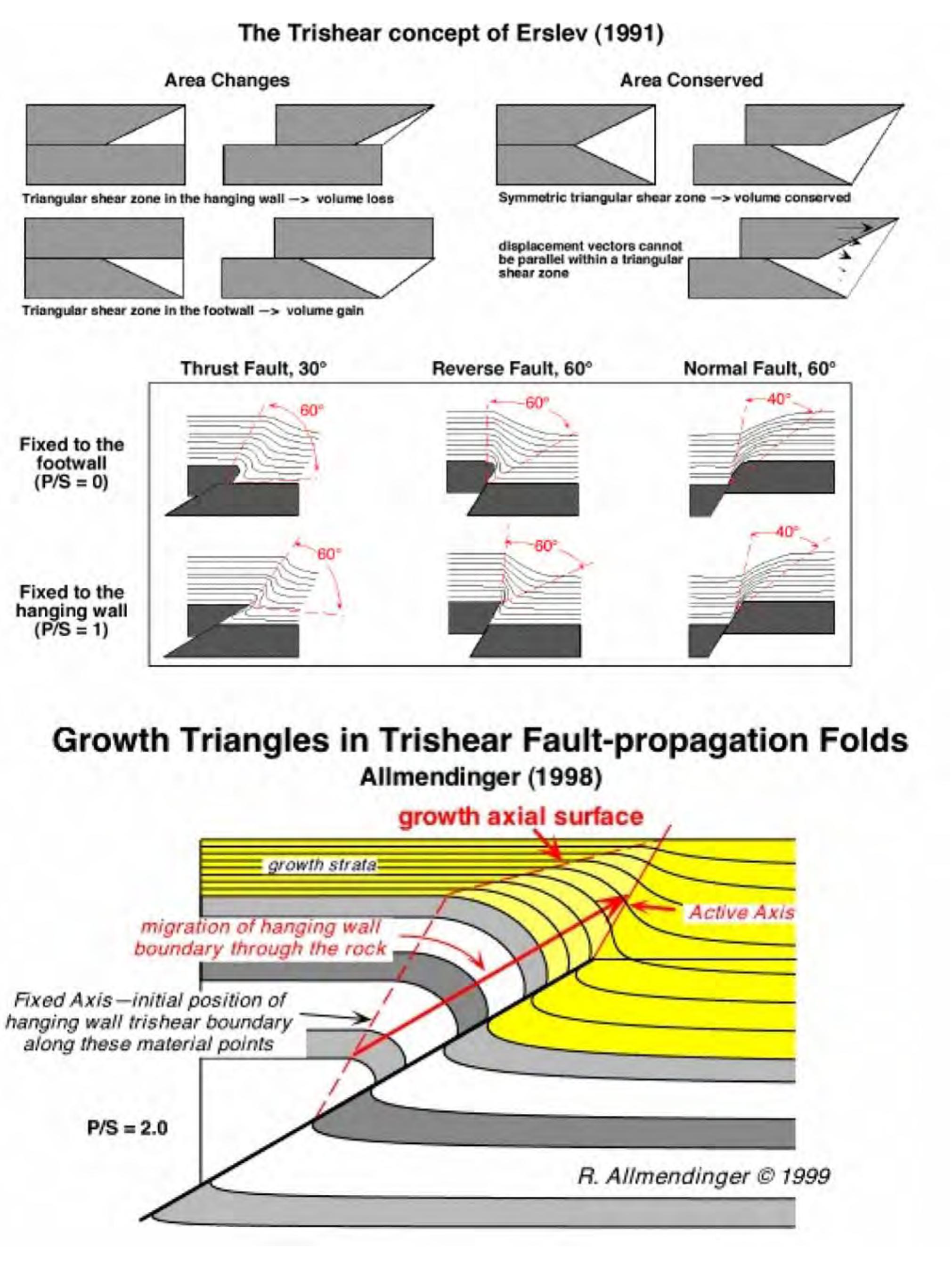




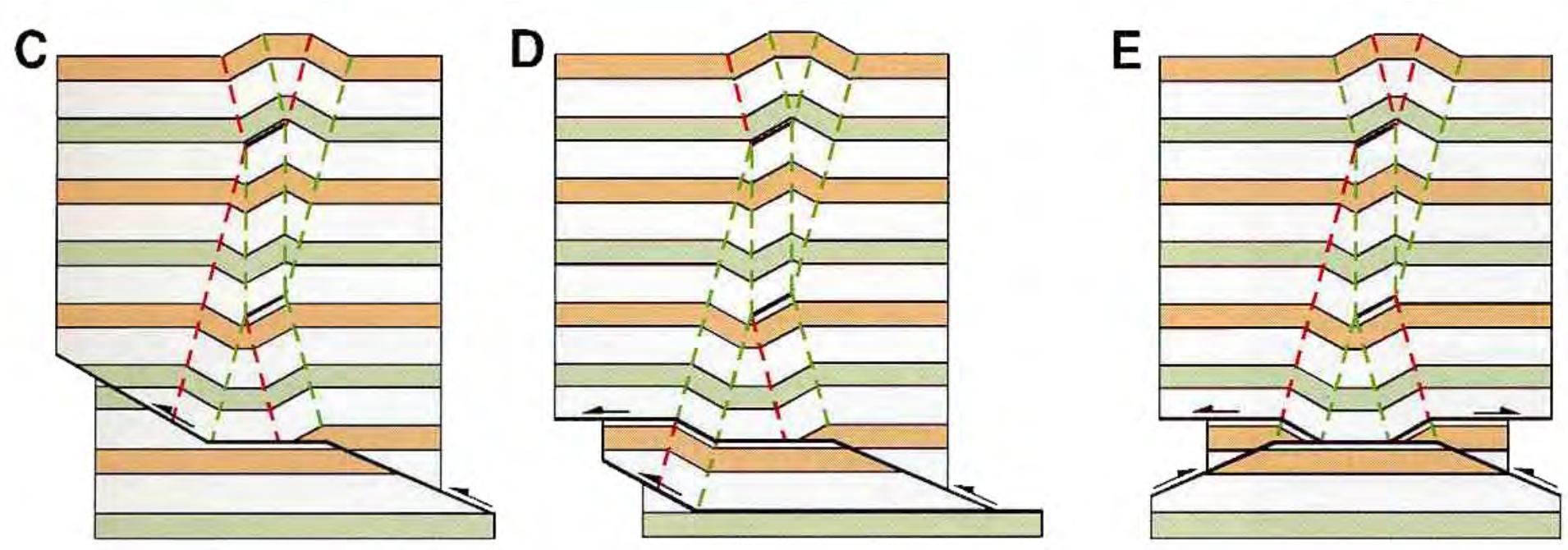








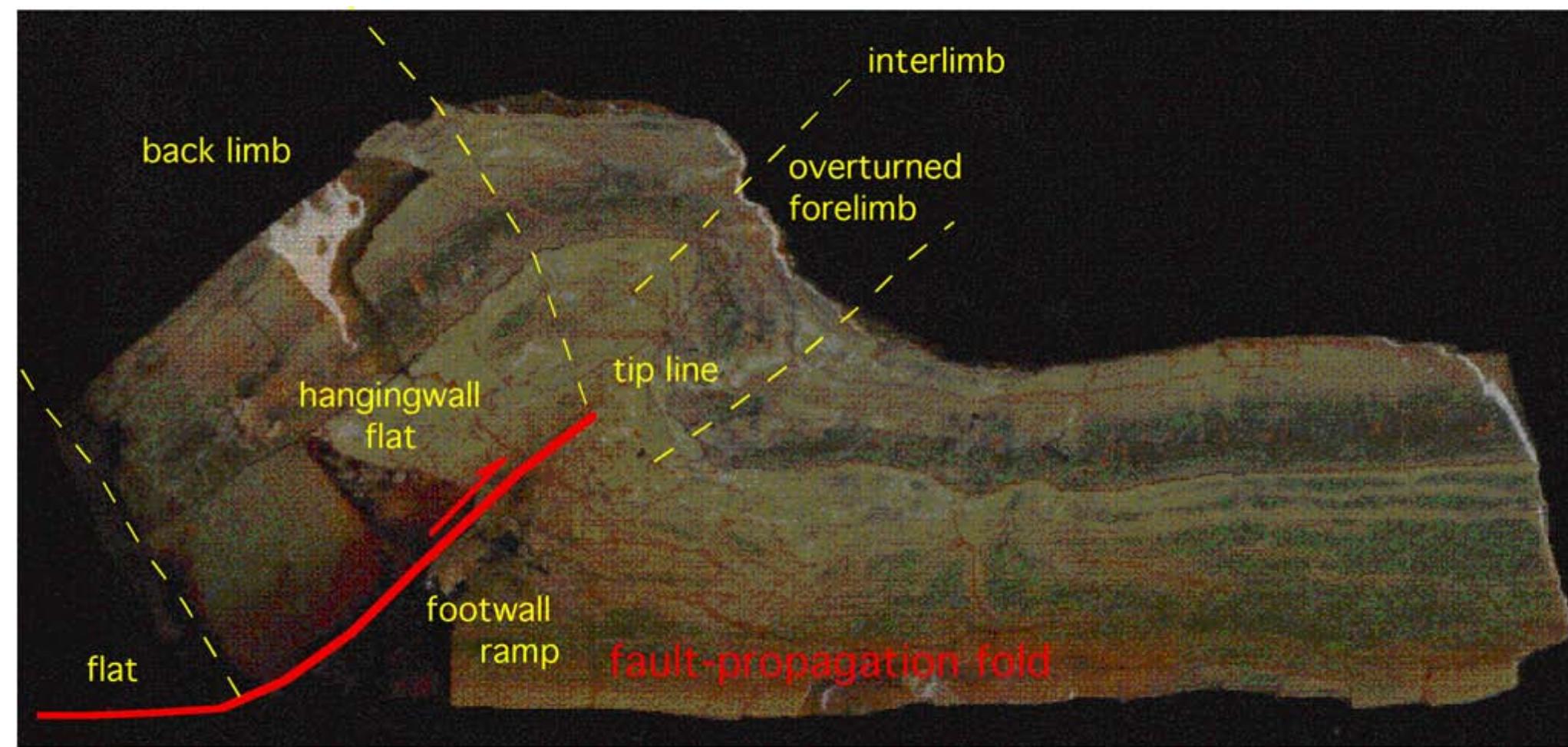



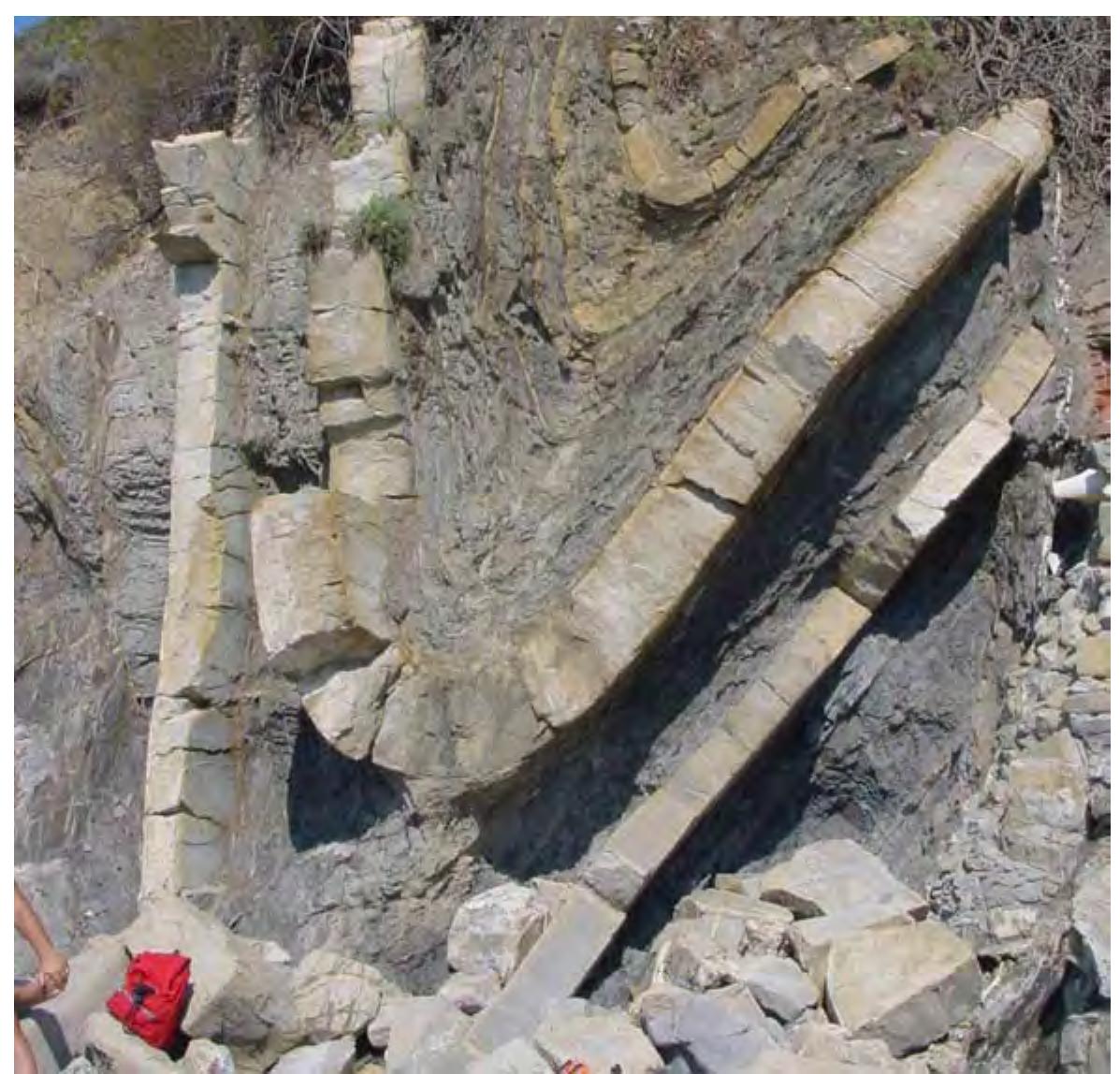



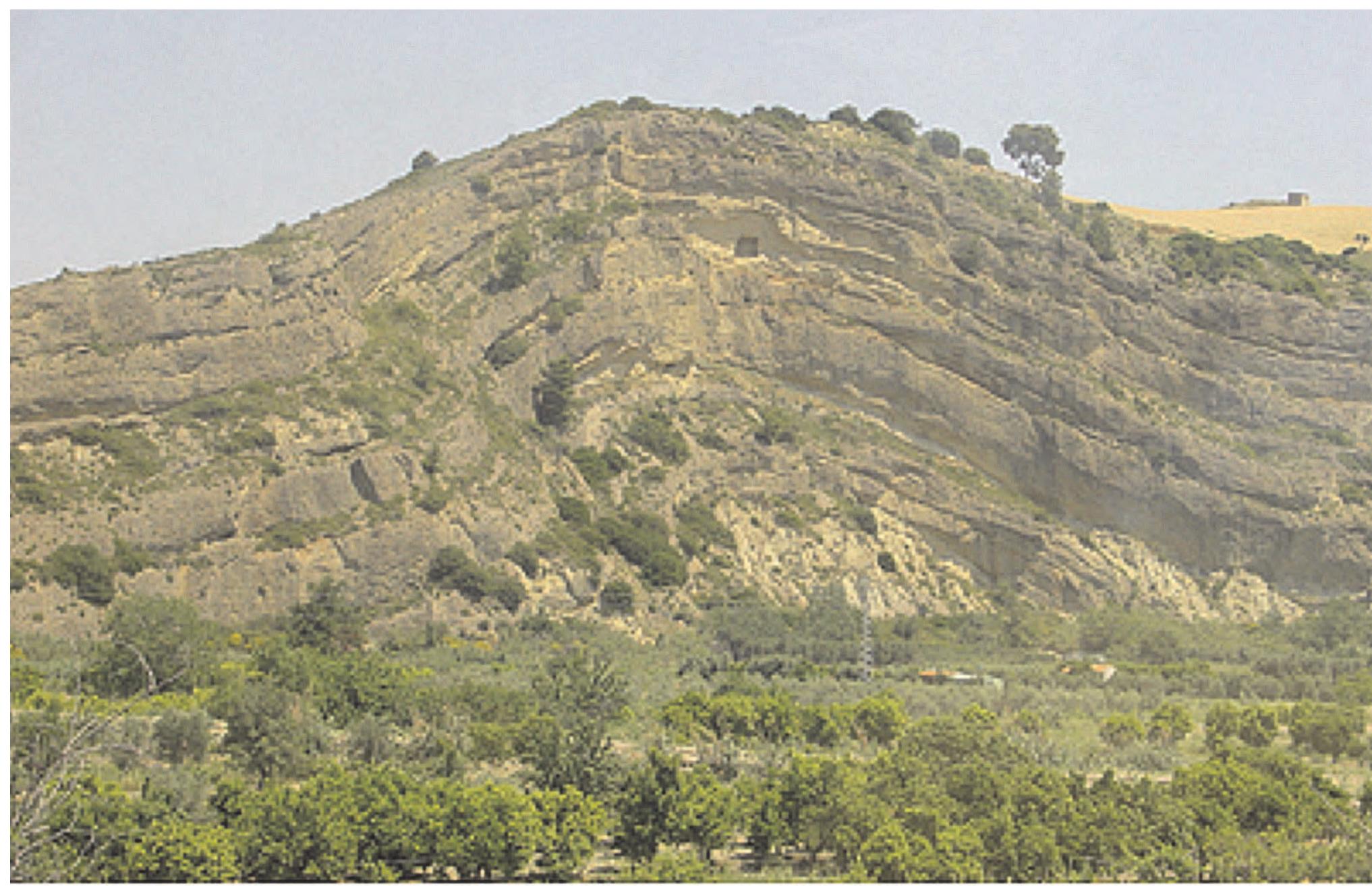






























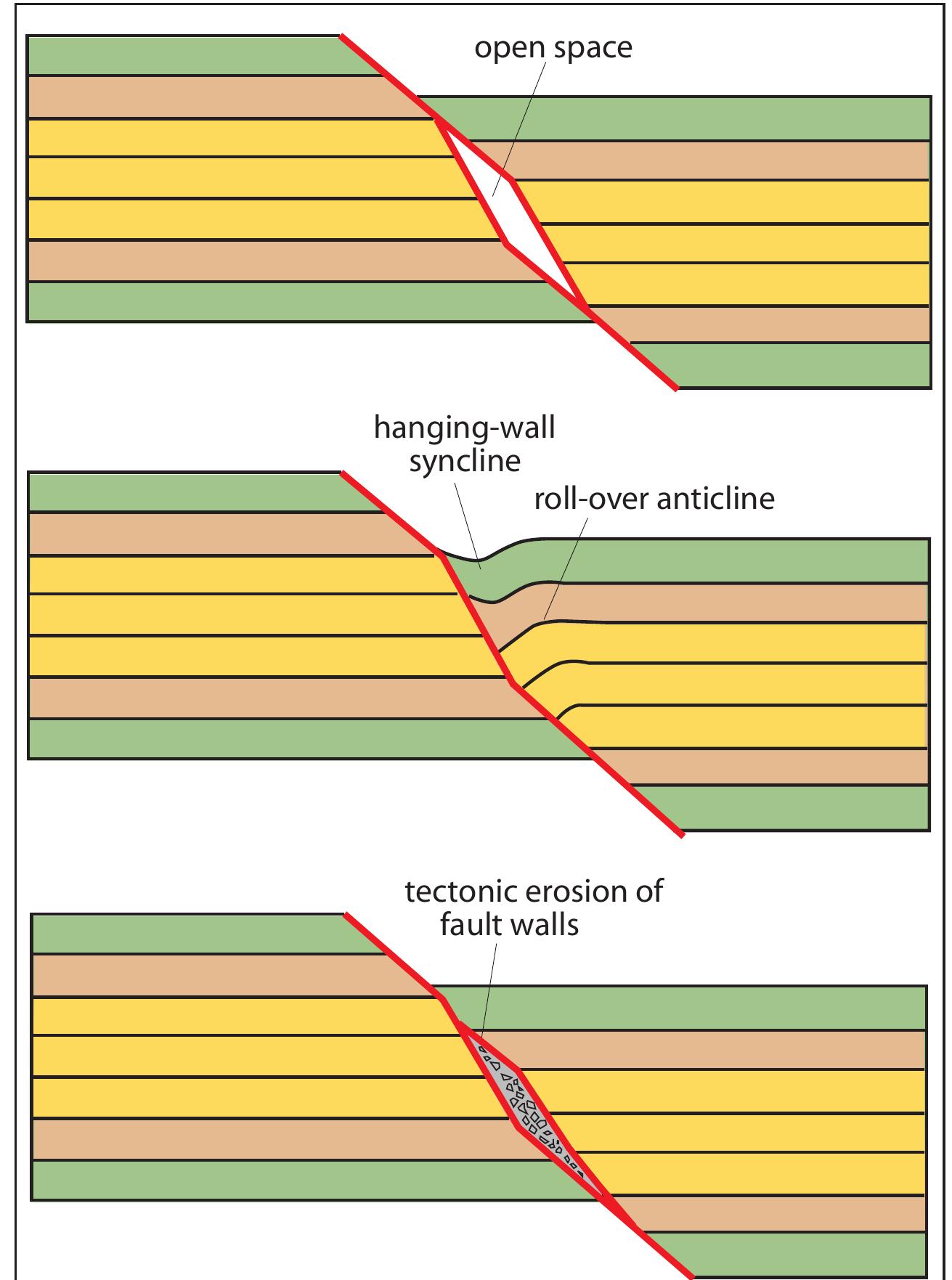








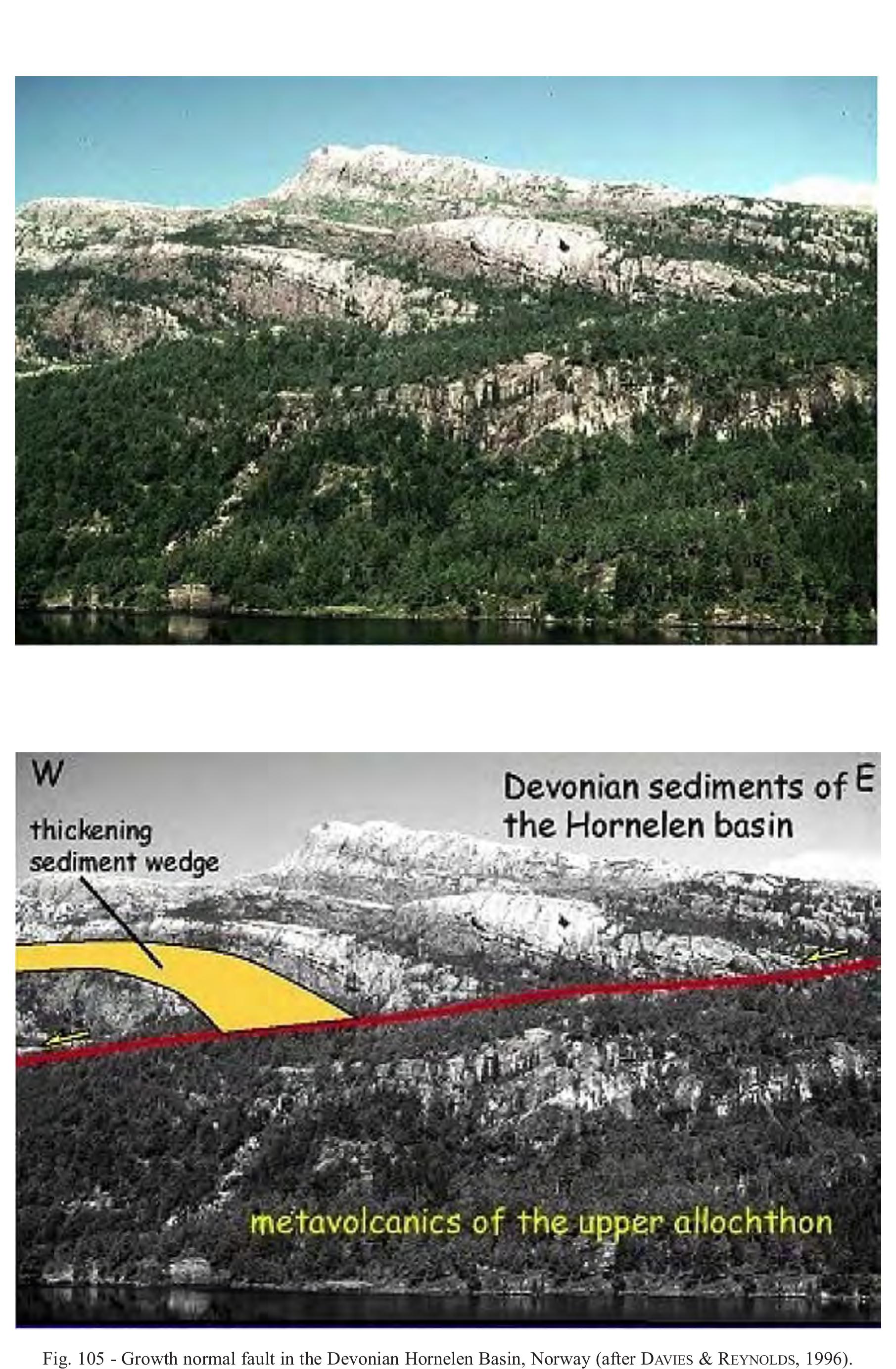














































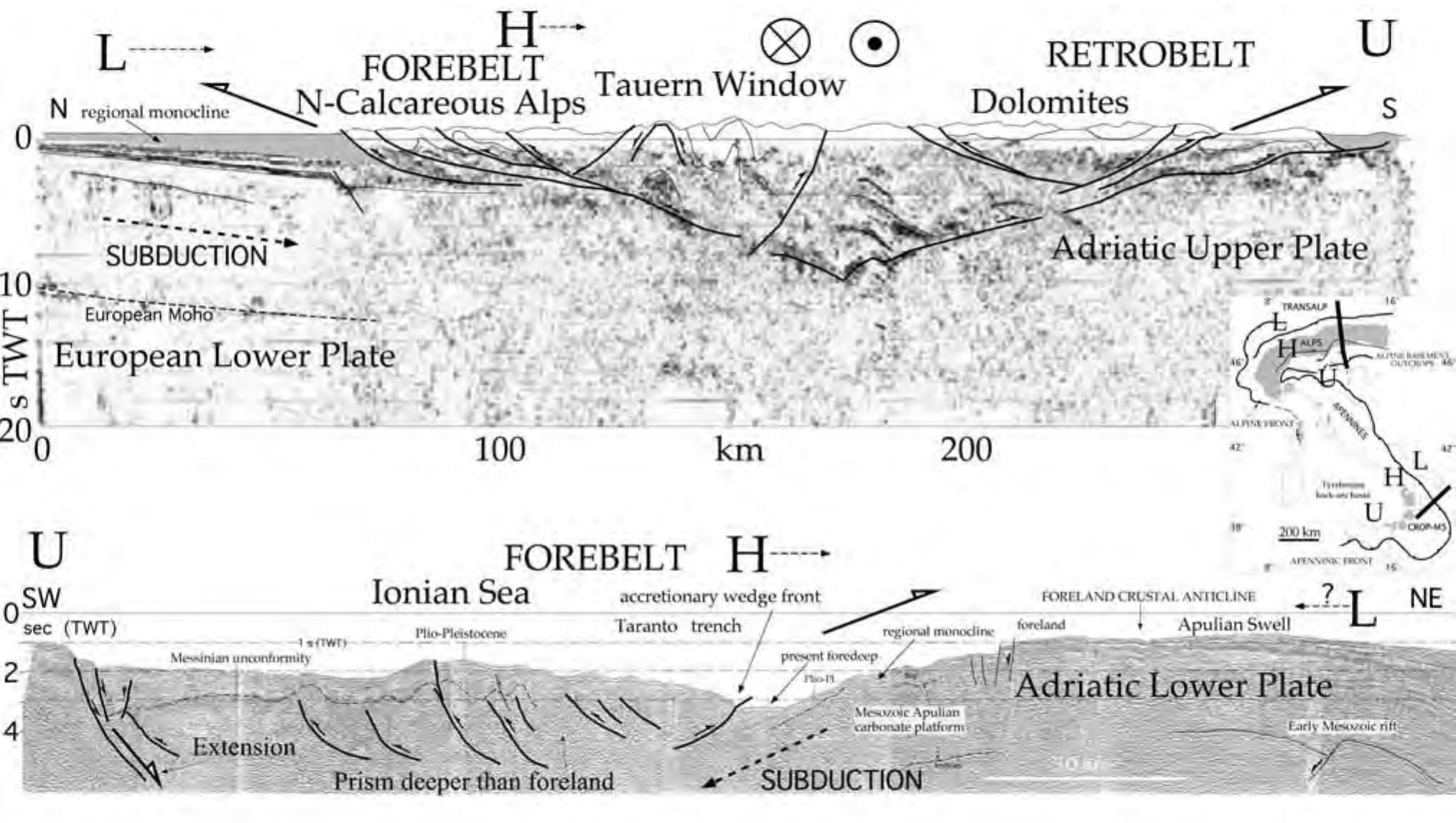





















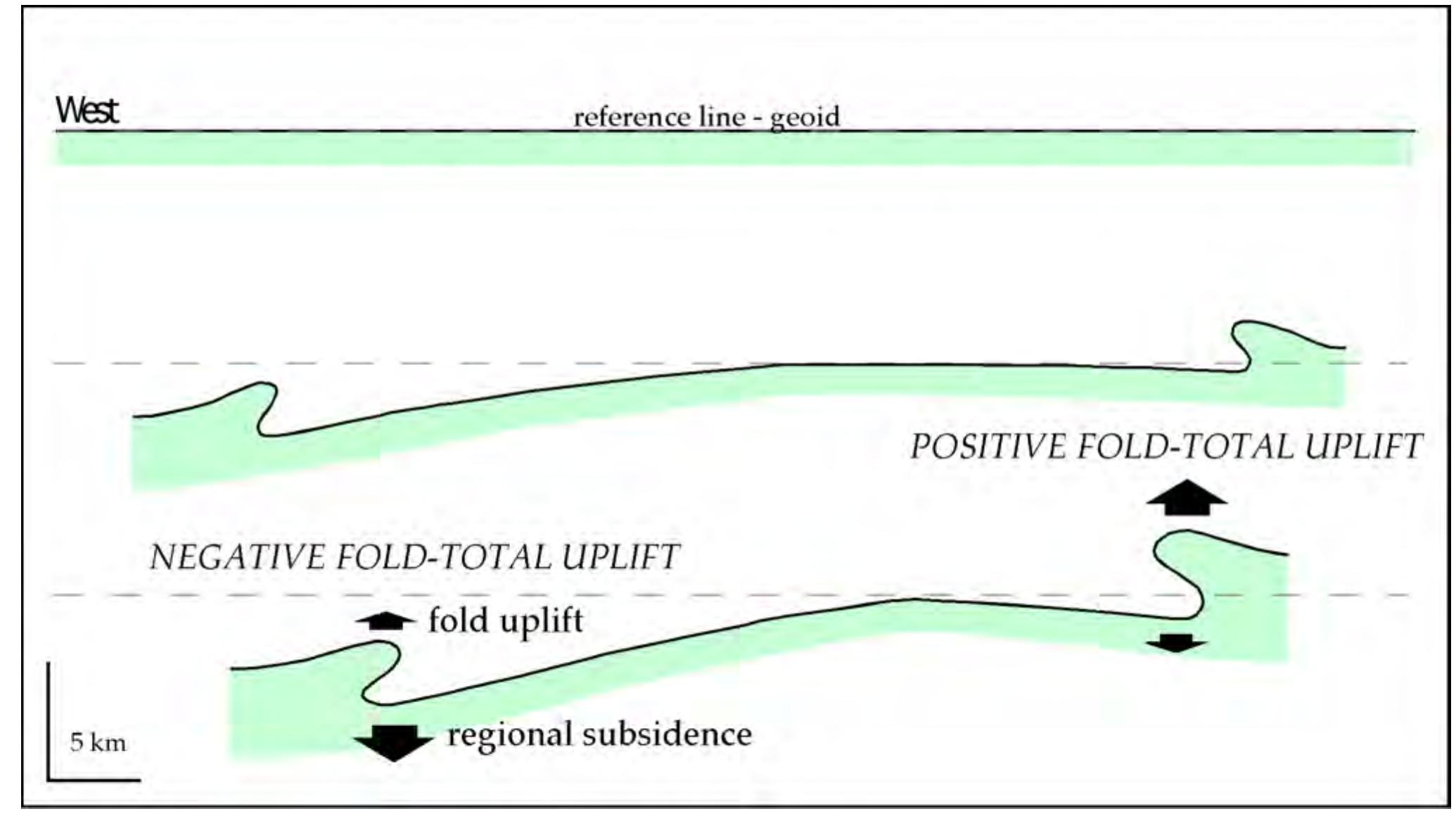





























































































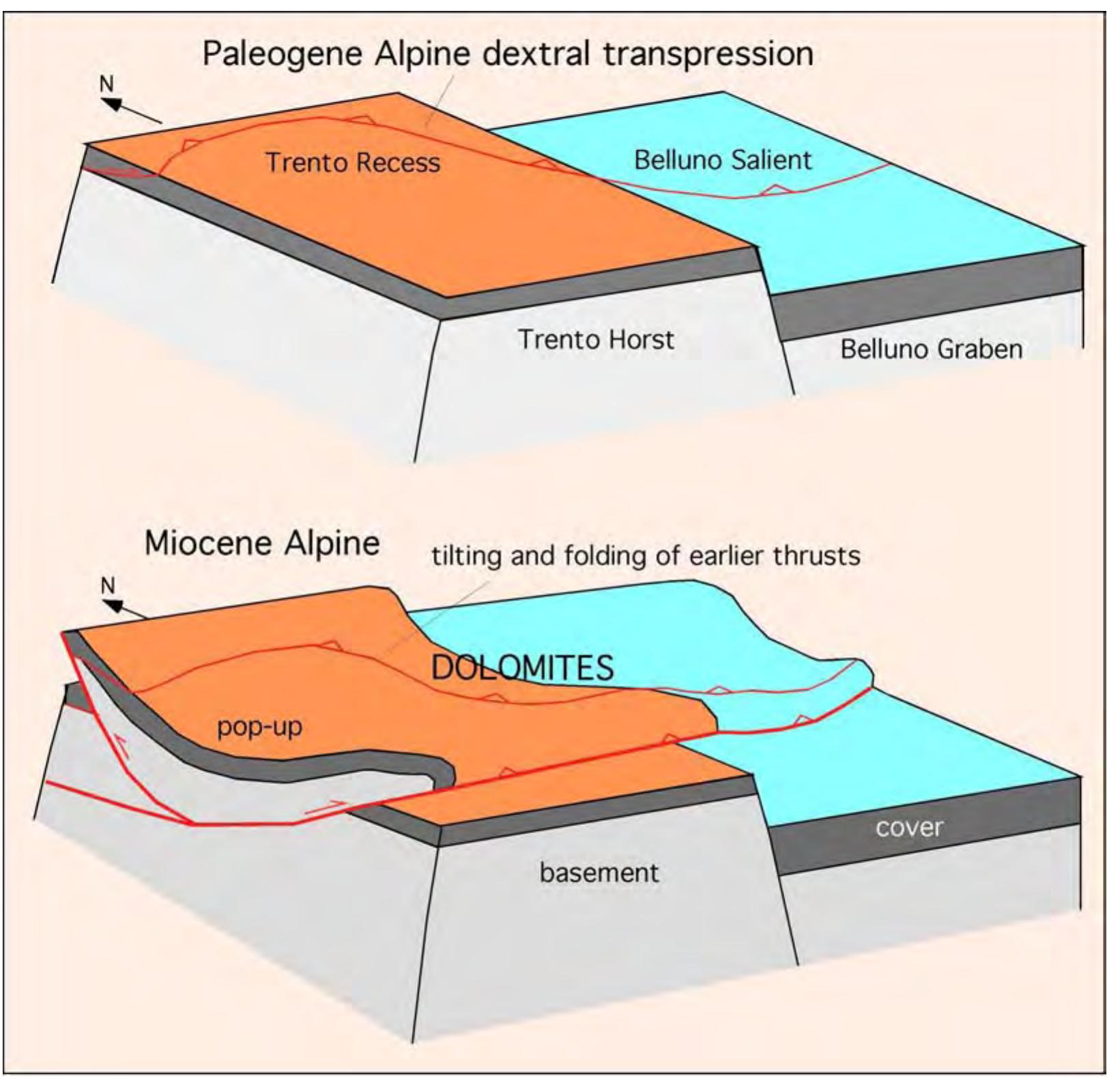


































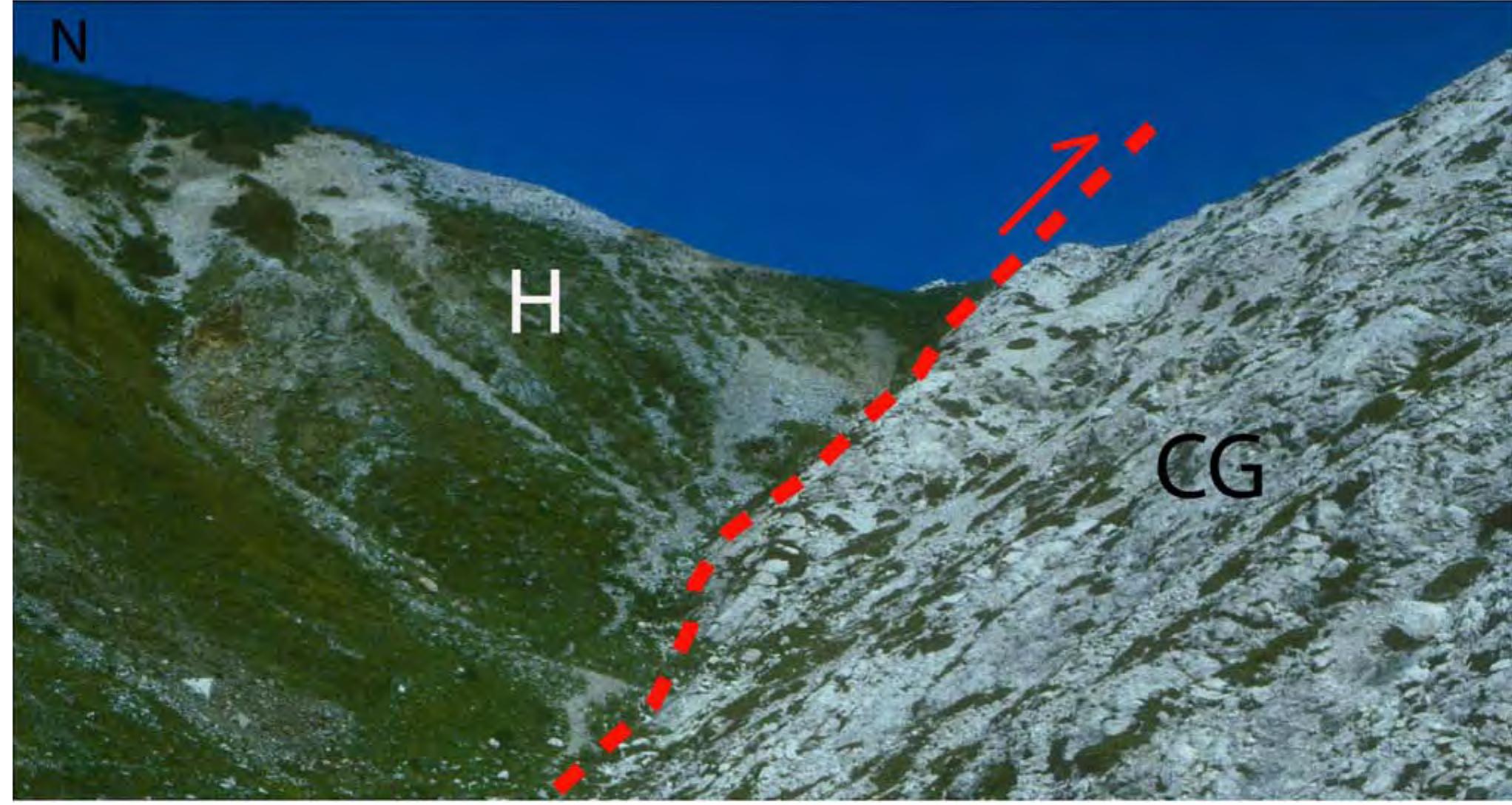














































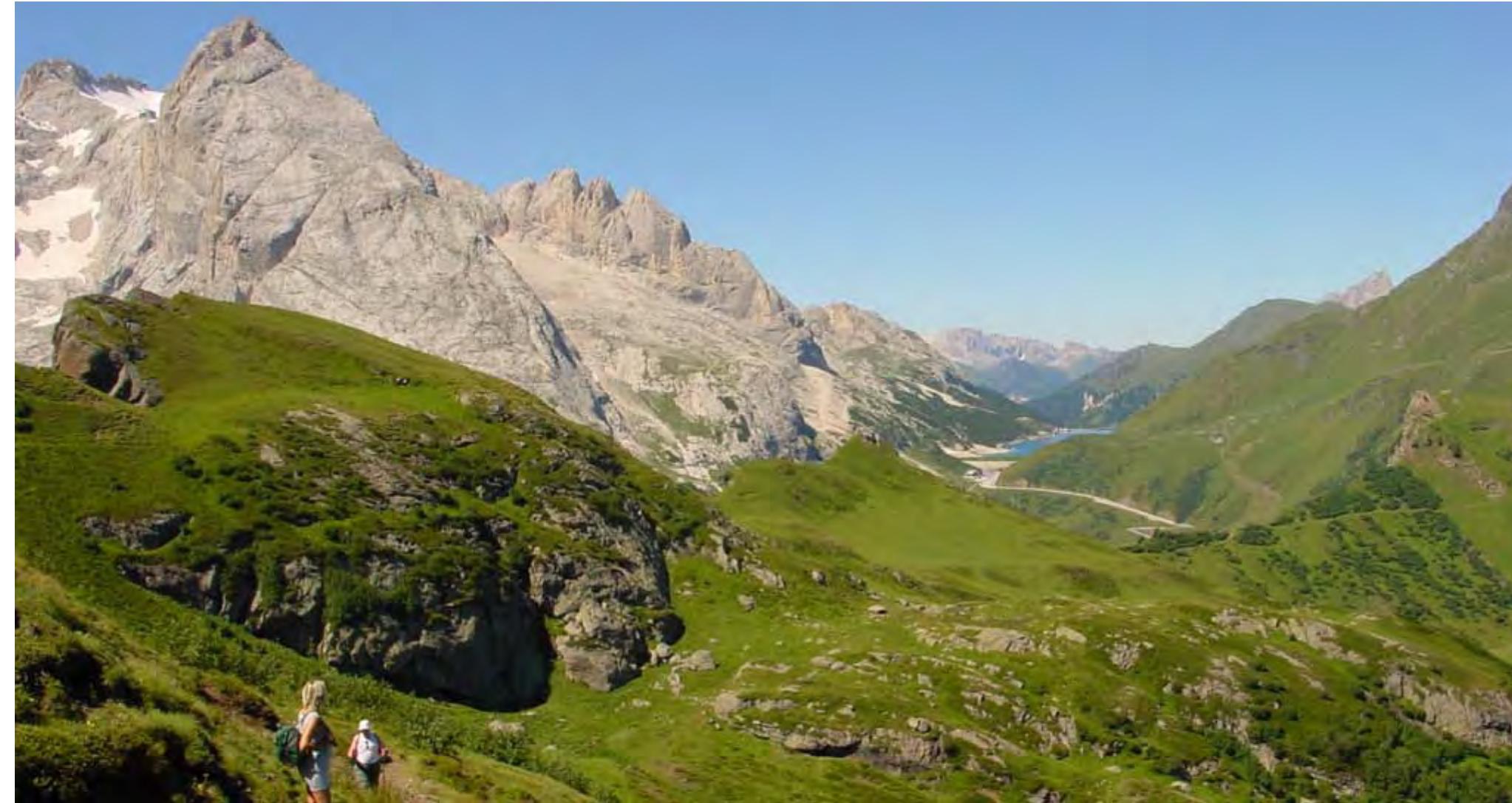
















































































Related papers
Tectonophysics, 1985
Boccaletti, M., Coli, M., Eva, C.
Swiss Journal of Geosciences, 2013
The Lepontine dome represents a unique region in the arc of the Central and Western Alps, where complex fold structures of upper amphibolite facies grade of the deepest stage of the orogenic belt are exposed in a tectonic half-window. The NW-verging Mont Blanc, Aar und Gotthard basement folds and the Lower Penninic gneiss nappes of the Central Alps were formed by ductile detachment of the upper European crust during its Late Eocene-Early Oligocene SE-directed underthrust below the upper Penninic and Austroalpine thrusts and the Adriatic plate. Four underthrust zones are distinguished in the NW-verging stack of Alpine fold nappes and thrusts: the Canavese, Piemont, Valais and Adula zones. Up to three schistosities S1-S3, folds F1-F3 and a stretching lineation XI with top-to-NW shear indicators were developed in the F1-F3 fold nappes. Spectacular F4 transverse folds, the SW-verging Verzasca, Maggia, Ziccher, Alpe Bosa and Wandfluhhorn anticlines and synclines overprint the Alpine nappe stack. Their formation under amphibolite facies grade was related to late ductile folding of the southern nappe roots during dextral displacement of the Adriatic indenter. The transverse folding F4 was followed since 30 Ma by the pull-apart exhumation and erosion of the Lepontine dome. This occurred coevally with the formation of the dextral ductile Simplon shear zone, the S-verging backfolding F5 and the formation of the southern steep belt. Exhumation continued after 18 Ma with movement on the brittle Rhone-Simplon detachment, accompanied by the N-, NW-and W-directed Helvetic and Dauphiné thrusts. The dextral shear is dated by the 29-25 Ma crustal-derived aplite and pegmatite intrusions in the southern steep belt. The cooling by uplift and erosion of the Tertiary migmatites of the Bellinzona region occurred between 22 and 18 Ma followed by the exhumation of the Toce dome on the brittle Rhone-Simplon fault since 18 Ma.
Journal of The Virtual Explorer, 2003
In this paper, we recall some aspects of the geology of central Italy, not fully consistent with the interpretation of the Tyrrhenian-Apennine system in the frame of a subduction context. Available near-vertical and deep-sounding seismic profiles across the Apennines of central Italy (e.g. CROP 03 and DSS ʻ78) do not show any evidence of an accretionary wedge above a subducting plane, but rather show a thick-skinned thrust belt with involvement of the overall crust in the deformation and with modest amounts of horizontal shortening. The relatively deep (<90 km) seismicity registered in Central Italy cannot be interpreted in terms of ongoing subduction. In fact, the hypocentral distributions do not mark the underthrusting of the Adriatic continental lithosphere beneath the Tyrrhenian lithosphere, but rather depict a seismogenic west-dipping thrust zone within the Adriatic lithosphere. The presence within the Apennine mountain chain of a carbonatite-potassic melilitite rock association, middle Pleistocene in age, points to a different geodynamic environment than subduction. In fact, this rock association is very rare and exclusively found in intra-continental rift context. The possibility to explain the evolution of the Tyrrhenian-Apennine system applying either a passive or an active (plume-related) rift context as alternative to subduction is briefly addressed. All considering, the evolution of the area is interpreted as the result of a peculiar combination of large-scale plume-induced lithospheric stretching and of local-scale rift push-induced crustal shortening, the latter progressively developed at the outer border of the extending region.
Earth Surface Processes and Landforms, 1993
Earth-Science Reviews, 2010
A new reconstruction of Alpine Tethys combines plate-kinematic modelling with a wealth of geological data and seismic tomography to shed light on its evolution, from sea-floor spreading through subduction to collision in the Alps. Unlike previous models, which relate the fate of Alpine Tethys solely to relative motions of Africa, Iberia and Europe during opening of the Atlantic, our reconstruction additionally invokes independent microplates whose motions are constrained primarily by the geological record. The motions of these microplates (Adria, Iberia, Alcapia, Alkapecia, and Tiszia) relative to both Africa and Europe during Late Cretaceous to Cenozoic time involved the subduction of remnant Tethyan basins during the following three stages that are characterized by contrasting plate motions and driving forces: (1) 131-84 Ma intra-oceanic subduction of the Ligurian part of Alpine Tethys attached to Iberia coincided with Eo-alpine orogenesis in the Alcapia microplate, north of Africa. These events were triggered primarily by foundering of the older (170-131 Ma) Neotethyan subduction slab along the NE margin of the composite African-Adriatic plate; subduction was linked by a sinistral transform system to E-W opening of the Valais part of Alpine Tethys; (2) 84-35 Ma subduction of primarily the Piemont and Valais parts of Alpine Tethys which were then attached to the European plate beneath the overriding African and later Adriatic plates. NW translation of Adria with respect to Africa was accommodated primarily by slow widening of the Ionian Sea; (3) 35 Ma-Recent rollback subduction of the Ligurian part of Alpine Tethys coincided with Western Alpine orogenesis and involved the formation of the Gibraltar and Calabrian arcs. Rapid subduction and arc formation were driven primarily by the pull of the gravitationally unstable, retreating Adriatic and African slabs during slow convergence of Africa and Europe. The upper European-Iberian plate stretched to accommodate this slab retreat in a very mobile fashion, while the continental core of the Adriatic microplate acted as a rigid indenter within the Alpine collisional zone. The subducted lithosphere in this reconstruction can be correlated with slab material imaged by seismic tomography beneath the Alps and Apennines, as well as beneath parts of the Pannonian Basin, the Adriatic Sea, the Ligurian Sea, and the Western Mediterranean. The predicted amount of subducted lithosphere exceeds the estimated volume of slab material residing at depth by some 10-30%, indicating that parts of slabs may be superposed within the mantle transition zone and/or that some of this subducted lithosphere became seismically transparent.
Geological Society of America Bulletin, 2011
Terra Nova, 2003
Marine and Petroleum Geology, 2004
A wide sector of the internal portion of the Central Apennines, which comprises the southern Lepini Mtns up to the northern Simbruini Mtns has been investigated through detailed field mapping and integrated with structural analyses. A few small productive oil fields and a large number of hydrocarbon seeps and oil impregnations are located in this sector. This area offers good opportunities for testing the use of structural fieldwork methodologies in order to highlight oil migrating paths, from Triassic source rocks, and prospecting chances for oil field exploitation.The main stages of the structural evolution of the area took place after deposition of the foredeep sediments (Frosinone Fm.), i.e. after Late Tortonian, under a stress field characterised by a NE–SW trending σ1, which was responsible for the early emplacement of major thrust faults present in the area. The Messinian-Early Pliocene thrust-top basin deposits allowed the reconstruction of an in-sequence evolution of the thrust system. The development of out-of-sequence thrusting post-dates these structures leading to a further strong shortening phase in the area during the Pliocene. This phase is characterised by a roughly NNE–SSW trending σ1. Some peculiar tectonic features evidenced by thrust faults with younger-over-older relationships and an inversion of the original stacking of thrust sheets developed during this phase.Successively, a block-faulting tectonic, mainly with NE–SW extension stress field, occurred and dismembered the compressive tectonic edifice.Later on up to the Middle Pleistocene, N–S to NNE–SSW trending dextral strike-slip faults also acted in the area. Associated to the strike-slip tectonics are local volcanic centres as well as necks, whose compositions show a mantle origin, thus indicating deep seating and a possible lithospheric significance of these structures.In the light of this study, the reduced extension of the productive oil area as well as the spotting of oil seeps, may indicate that the migration conditions are not tied to well defined structures but that likely the cross-cutting points among structures facilitate the conditions for an upwards rising of oil. These conditions in particular are achieved at least in two cases: (1) where the Late Triassic source rocks do not have great depth due to normal or reverse faults, or (2) at a major depth when encountered by transcurrent-oblique roughly N–S trending faults—in both cases oil can easily migrate along the damage zone associated to the fault plane.
Tectonics, 1994
The Adriatic region forms an intermediate continental foreland overthrust along its northeastern margin by the southwest vergent Dinaric thrust belt in Eocene-Oligocene time and along its southwestern margin by the northeast vergent Apennine thrust belt in Pliocene-Quaternary time. Orogenic activity within these thrust belts was accompanied by the development of two superposed foredeep basin systems of opposite polarity and different ages. Using well log, biostratigraphic, and seismostratigraphic data, the geometry of this composite basin system was reconstructed along three profiles at beginning of Quaternary, middle Pliocene, beginning Pliocene, and beginning Eocene time. Modeling of reconstructed geometries using a thin elastic sheet approximation yields a range of acceptable effective elastic plate thicknesses for the central Adriatic region of Te=5-10 km for Eocene-Oligocene flexure and Te= 10-15 km for Pliocene-Quaternary flexure (although an upper bound for Te could not be established on one of the three profiles). These results are consistent with a constant effective elastic plate thickness of Te=10 km for the Adriatic lithosphere and preclude the possibility that significant weakening of the Adriatic plate occurred between flexural events. Modeling of incremental deflections between Pliocene and Quaternary time gives results consistent with constant values of Te=10 km in the central Adriatic and Te=15 km in the northern Adriatic and Po Plain and shows little evidence for weakening of the plate during Pliocene-Quaternary time. Thus within the resolution of the data presented in this paper, there is little evidence for viscous relaxation of the lithosphere on time scales between about 2 and 50 m.y. Analysis of bending of an idealized lithosphere with a simple brittle-elasticductile theology, and a low to moderate thermal gradient suggests that the small values of Te observed within the Adriatic region can be readily understood as the result of bending of the lithosphere to unusually high curvature (4 x l0 -6 m -1) and do not require unusually high temperatures within the foreland lithosphere. The same theological model is also consistent with the absence of significant inelastic Paper number 93TC01935 0278-7407/94/93TC-01935510.00 yielding for at least 50 m.y. after the cessation of loading. An apparent unbending of the Adriatic lithosphere began in early Quaternary time, approximately coeval with the cessation of major thrusting within the Apennine thrust belt. The threedimensional pattern of Quaternary deflection makes it difficult to attribute this phenomenon to local depositional processes and suggests that unbending reflects a fundamental change in the subduction process in early Quaternary time. Our preferred interpretation is that unbending is the result of a diminution of forces acting on the subducted Adriatic lithosphere at mantle depths. The Dinaride and Apennine orogenic belts have formed in response to local accommodation of convergence between the Eurasian and African plates in Cenozoic time. Between these two thrust belts lies an intermediate continental foreland lithosphere, overthrust from the northeast by the Dinaric nappes and from the southwest by the Apennine nappes. This intermediate foreland currently underlies the northern Adriatic Sea and the Po Plain of Italy and is referred to here as the Adriatic lithosphere or Adriatic fragment (many authors also refer to it as Apulia, particularly in discussions of southern Alpine tectonics). The basement of the Adriatic fragment forms a central high and deepens to the northeast and to the southwest toward the opposing thrust belts. The Moho lies at 25-to 35-km depth in the northern Adriatic Sea and deepens to the west [Finetti et al., 1966; Giese and Morelli, 1975; Cermak, 1978]. The foredeep basin along the northeastern side of the Adriatic Sea and the Dinaride thrust belt of Yugoslavia developed contemporaneously with southwest vergent thrusting in the Dinaric Alps in Eocene-Oligocene time. Thrusting involved Mesozoic and Paleozoic sedimentary rocks as well as Cenozoic sedimentary rocks deposited in the internal (northeastern) parts of the foredeep basin. The amount of shortening recorded in the Dinaride thrust belt increases southward, reaching several hundreds of kilometers in the southern Dinarides (for a summary, see Burchfiel [1980]). External to (southwest of) the Dinaric thrust belt, late Cretaceous to early Eocene(?) reefs indicate a shallow marine environment within much of the Dinaric foreland. These carbonate rocks are overlain by Eocene to Miocene clastic deposits that fill the foredeep basin and thicken toward the northeast, reaching a maximum thickness of 5-6 km. Subsidence of the foredeep basin and thrusting within the Dinarides ceased probably by Oligocene time. Eocene to Miocene sedimentary rocks in the foredeep are overlain by Pliocene sedimentary rocks associated with the development of the Apennine foredeep basin. Pliocene development of the Apennine thrust belt and western Adriatic foredeep basin postdates tectonic activity in the Dinarides. Northeast directed thrusting in the Apennine thrust belt occurred throughout Miocene and Pliocene time in response to southwestward subduction of the Adriatic lithosphere beneath the mountain belt [Civetta et al., 1978; Mantovani et al., 1992]. The thrust belt migrated to Southern ps Po Plain D 200 km Tyrhennian Sea 28o Kruse and Royden: Bending of the Adriatic Lithosphere the east throughout middle and late Miocene time, transporting sedimentary rocks originally deposited on the Adriatic plate and stripped from their basement during thrusting [e.g., Ogniben et al., 1975; Bally et al., 1986; Cooper, 1988]. The present Apennine-Po foredeep basin was formed in Pliocene-Quaternary time, but remnants of older foredeep basins can be found within the thrust belt itself [e.g., Patacca and Scandone, 1989]. The present basin thickens uniformly to the southwest, containing up to 8 km of Pliocene-Quaternary sediments [Ogniben et al., 1975; Pieri and Groppi, 1981]. At least 60-170 km of shortening is estimated to have occurred across the central Apennines in Pliocene-Quaternary time [Bally et al., 1986]. Evidence pointing toward significant west dipping subduction of the Adriatic lithosphere beneath the Apennine thrust belt includes palinspastic restorations that show up to several hundred kilometers of shortening across the belt [Bally et al., 1986] and the presence of arc volcanism along the Italian peninsula [Barberi et al., 1974]. A narrow, northwest-dipping Benioff zone exists west of the southernmost portion of the Apennines and the Calabrian arc, with hypocenters to 600-km depth [Gasparini et al., 1982]. West of the Apennine mountains, late Miocene-Pliocene extension within the overriding plate has Publ., 414, 1-13, 1981. Royden, L., Flexural behavior of the continental lithosphere in Italy: Constraints imposed by gravity and deflection data, J. Geophys. Res., 93, 7747-7766, 1988. Royden, L., E. Patacca, and P. Scandone, Segmentation and configuration of subducted lithosphere in Italy: An important control on thrust belt and foredeep basin evolution, Geology, 15, 714-717, 1987. Royden, L. H.,The tectonic expression of slab pull at continental convergent boundaries, Tectonics, 12, 303-325, 1993. Ruggieri, G., D. Rio, and R. Sprovieri, Remarks on the chronostratigraphic classification of lower Pleistocene, Boll. Soc. Geol. Ital., 103, 251-259, 1984. Sclater, J. G., and P. A. F. Christie, Continental stretching: An explanation of the post-mid-Cretaceous subsidence of the central North Sea basin, J. Geophys. Res., 85, 3711-3739, 1980.

Loading Preview
Sorry, preview is currently unavailable. You can download the paper by clicking the button above.
References (398)
- ACCORDI B. (1955) -Le dislocazioni delle cime (Gipfelfaltungen) delle Dolomiti. Ann. Univ. Ferrara (9), Sci. geol. pale- ont. 2: 65-188.
- ALLMENDINGER R.W., BROWN L.D., OLIVER J.E. & KAUFMAN S. (1983) -COCORP deep seismic profiles across the Wind River mountains, Wyoming. In: A.W. BALLY (Ed.), Seismic expression of structural styles. Amer. Ass. Petrol. Geol., Studies in Geology, v. 15, 3.2.1.29- 3.2.1.33 pp.
- ALLMENDINGER R.W. (1998) -Inverse and Forward numerical modeling of trishear fault-propagation folds. Tectonics, v. 17: 640-656.
- ANDERSON E.M. (1905) -The dynamics of faulting, Transactions of the Edimburgh Geological Society, 8: 387-402, 1905.
- ASSERETO R. et alii (1977) -The Pb-Zn mineralization in the Triassic of the Dolomites. Geological History and gene- tic interpretations. L'industria mineraria, nov.-dic., 367-402.
- BACHMANN G.H. & KOCH K. (1983) -Alpine Front and Molasse Basin, Bavaria. In: Seismic expression of struc- tural styles; a picture and work atlas; Volume 3. A- W BALLY (editor), Am. Ass. Petrol. Geol. Studies in Geology, 15: 3.4.1-27-3.4.1-32.
- BADLEY M.E. (1985) -Practical Seismic Interpretation, New Jersey, Prentice Hall.
- BALLY A.W. (1984) -Tectogenèse et sismique réflexion. Bull. Soc. géol. France, 7: 279-285.
- BALLY A.W., GORDY P.L. & STEWART G.A. (1966) - Structure, seismic data and orogenic evolution of Southern Canadian Rocky Mountains. Bull. Canad. Petrol. Geol.,14: 337-381.
- BARBIERI G. (1987) -Lineamenti tettonici degli Altipiani Trentini e Vicentini tra Folgaria e Asiago (Prealpi Venete). Mem. Scienze Geol., 39: 257-264, Padova.
- BECHSTADT T. & BRANDNER R. (1970) -Das Anis zwischen St.Vigil und dem Holensteintal (Pragser und Olanger Dolomiten, Sudtirol). Beitrage zur Mikrofazies und Stratigraphie von Tirol und Voralberg. (Festb.Geol. Inst., 300-J. Feier Univ. Innsbruck), 9-103.
- BECHSTADT T., BRANDNER R., MOSTLER H. & SCHMIDT K. (1977) -Aborted rifting in the Triassic of the Eastern and Southern Alps. N. Jb. Geol. Palaont. Abh., 156, 2: 157- 178. BERGE T.B. & VEAL S.L. (2005) -Structure of the Alpine foreland. Tectonics, 24, TC5011, doi: 10.1029/2003TC001588.
- BERNOULLI D. (1964) -Zur Geologie des Monte Generoso (Lombardische Alpen). Beitr. Geol. Karte Schweiz, Neue Folge, Bern, 134.
- BERNOULLI D., BICHSEL M., BOLLI H., HAERING H., HOCHULI P. & KLEBOTH P. (1981) -The Missaglia Megabed, a catastrophic deposit in the upper Cretaceous Bergamo Flysch (Northern Italy). Eclogae Geol. Helv., 74/2, 421-442.
- BERNOULLI D., CARON C., HOMEWOOD P., KALIN O. & VON STUIJVENBERG J. (1979) -Evolution of continen- tal margins in the Alps. Schweiz. Mineral. Petrogr. Mitt., 59: 165-170.
- BERNOULLI D., HEITZMANN P. & ZINGG A. (1990) - Central and southern Alps in southern Switzerland: tectonic evo- lution and first results of reflection seismics. Mém. Soc. géol. France 156: 289-302.
- BERNOULLI D. & LEMOINE M. (1980) -Birth and Early Evolution of the Tethys: the Overall Situation. Mem. B.R.G.M., 115: 168-179.
- BERNOULLI D. & WINKLER W. (1990) -Heavy mineral assemblages from Upper Cretaceous South-and Austroalpine flysch sequences (Northern Italy and Southern Switzerland): source terranes and paleotectonic implications. Ecolgae Geol. Helv., 83/2: 287-310.
- BERSEZIO R. & FORNACIARI M. (1987) -Cretaceous sequen- ces in the Lombardy Basin: stratigraphic outline between the Lakes of Lecco and Iseo. Mem. Soc. Geol. It., 40: 187- 197. BERSEZIO R. & FORNACIARI M. (1988) -Geometria e carat- teri stratigrafici della Sequenza Cenomaniana nel Bacino Lombardo (Alpi Meridionali). Riv. It. Paleont. Strat., 94/3: 425-454.
- BERSEZIO R. & FORNACIARI M. (1988) -Tectonic framework of the Lombardy foothills (Southern Alps) between Brianza and Lake Iseo. Rend. Soc. Geol. It., 11: 75-78.
- BERTOTTI G. (1990) -The deep structure of the Monte Generoso basin: an extensional basin in the south-Alpine Mesozoic passive continental margin. Mém. Soc. géol. France 156: 303-308.
- BERTOTTI G., PICOTTI V., BERNOULLI D. & CASTELLARIN A. (1993) -From rifting to drifting: tectonic evolution of the South-Alpine upper crust from the Triassic to the Early Cretaceous. Sedimentary Geology, 86: 53-76.
- BIGI G., CASTELLARIN A., CATALANO R., COLI M., COSENTINO D., DAL PIAZ G.V., LENTINI F., PAROTTO M., PATACCA E., PRATURLON A., SALVINI F., SARTORI R., SCANDONE P. & VAI G.B. (1989) - Synthetic structural-kinematic map of Italy, scale 1:2.000.000. CNR, Progetto Finalizzato Geodinamica, Roma.
- BLENDINGER W. (1983) -Anisian sedimentation and tectonics of the M.Pore-M.Cernera area (Dolomites). Riv. It. Paleont.Strat., 89: 175-208.
- BLENDINGER W. (1985) -Middle Triassic strike-slip tectonics and igneous activity of the Dolomites (Southern Alps).
- Tectonophysics, 113: 105-121.
- BLENDINGER W. (1986) -Isolated stationary carbonate plat- forms: the Middle Triassic (Ladinian) of the Marmolada area, Dolomites, Italy. Sedimentology, 31: 1-24.
- BOSELLINI A. (1965) -Lineamenti strutturali delle Alpi Meridionali durante il Permo-Trias. Mem. Museo St. Nat. Ven. Trid., 15, 3: 1-72.
- BOSELLINI A. (1968) -Paleogeologia pre-anisica delle Dolomiti centro-settentrionali. Atti Acc. Naz. Lincei, Rend. Cl. Sc. Fis. Mat. Nat., 8,9: 1-32.
- BOSELLINI A. (1973) -Modello geodinamico e paleotettonico delle Alpi Meridionali durante il Giurassico-Cretacico. Sue possibi- li applicazioni agli Appennini. In: B. ACCORDI (ed) Moderne vedute sulla geologia dell'Appennino, Accad. Naz. Lincei, 183: 163-205, Roma.
- BOSELLINI A. (1982) -Geologia dei passi dolomitici circostanti il Gruppo di Sella. In: Guida alla Geologia del Sudalpino centro-orientale. Eds. A. CASTELLARIN & G.B. VAI, Guide Geol. Reg. Soc. Geol. It., 267-272.
- BOSELLINI A. (1984) -Progradation geometries of carbonate plat- forms: examples from the Triassic of the Dolomites, northern Italy. In: Reefs in Time and Space Ed. by L.F. LAPORTE, Spec. Publ. Soc. econ. Paleont. Miner., 18: 209-233.
- BOSELLINI A. (1991) -Geology of the Dolomites, An introduc- tion. Dolomieu Conference on Carbonate Platforms and Dolomitization, 1-43.
- BOSELLINI A. (1996) -Geologia delle Dolomiti. 1-192 pp., Athesia, Bolzano.
- BOSELLINI A. & DOGLIONI C. (1986) -Inherited structures in the hangingwall of the Valsugana Overthrust (Southern Alps, Northern Italy). Journ. Struct. Geol., 8, 5: 581-583.
- BOSELLINI A. & DOGLIONI C. (1988) -Progradation Geometries of Triassic Carbonate Platforms of the Dolomites, and their Large-Scale Physical Stratigraphy. Am. Assoc. Petrol. Geol. Nice Conference, Guide Book field trip 6: 1-42.
- BOSELLINI A. & FERRI R. (1980) -La Formazione di Livinallongo (Buchenstein) nella Valle di S. Lucano (Ladinico inferiore, Dolomiti Bellunesi). Ann. Univ. Ferrara, IX, 6: 63-89.
- BOSELLINI A., GIANOLLA P. & STEFANI M. (2003) - Geology of the Dolomites. Episodes, 26, 3: 181-185.
- BOSELLINI A. & HARDIE L.H. (1973) -Depositional theme of a marginal marine evaporite. Sedimentology, 20: 5-27.
- BOSELLINI A. & MASETTI D. (1972) -Ambiente e dinamica deposizionale del calcare del Vajont (Giurassico medio. Prealpi Bellunesi e Friulane). Annali Univ. Ferrara, 5, 4: 87-100.
- BOSELLINI A., MASETTI D. & SARTI M. (1981) -A Jurassic "Tongue of the ocean" infilled with oolitic sands: the Belluno trough, Venetian Alps, Italy. Mar. Geol., 44: 59-95.
- BOSELLINI A. & NERI C. (1991) -The Sella Platform (Upper Triassic, Dolomites, Italy). Dolomieu Conference on Carbonate Platforms and Dolomitization. Guidebook Excursion B, 1-30.
- BOSELLINI A. & ROSSI D. (1974) -Triassic carbonate buildups of the Dolomites, Northern Italy. In: Reef in Time and Space, L.F. LAPORTE (Ed), Spec. publ. Soc. econ. Palaeont. Miner., 18: 209-233.
- BOSELLINI A. & STEFANI M. (1991) -The Rosengarten: A platform-to-basin carbonate section (Middle Triassic, Dolomites, Italy). Dolomieu Conference on Carbonate Platforms and Dolomitization. Guidebook Excursion C, 1-24.
- BOSTROM R.C. (1971) -Westward displacement of the lithosphe- re. Nature, 234: 536-538.
- BOYER G.R. (1914) -Étude géologique des environs de Longarone (Alpes Venetiennes). Bull. Soc. Géol. France, 4, 13 (1913), 8: 451-485.
- BOYER S.E. & ELLIOTT D. (1982) -Thrust systems. Amer. Ass. Petrol. Geol., 66: 1196-1230, Tulsa.
- BOZZO G.P. & SEMENZA E. (1973) -Nuovi elementi tettonici del vallone di Fadalto e loro inquadramento nella struttura del veneto nordorientale. Boll. Mus. Civ. St. Nat. Venezia, suppl. 12: 11-25, Venezia.
- BRACE W. F. & KOHLSTEDT D. L. (1980) -Limits on litho- spheric stress imposed by laboratory experiments, J. Geophys. Res, 85: 6248-6252.
- BRACK P. (1981) -Structures in the south western border of the Adamello intrusion (Alpi Bresciane, Italy). Schweiz. Mineral. Petr. Mitt., 61: 37-50.
- BRACK P. (1983) -Multiple intrusions-examples from the Adamello batholith (Italy) and their significance on the mecha- nisms of intrusion. Mem. Soc. Geol. It., 26: 145-157.
- BRACK P. (1984) -Geologie der Intrusiva und Rahmengesteine des SW-Adamello. Diss. nr. 7612, ETH, Zürich.
- BRACK P., MUNDIL R., OBERLI F., MEIER M., & RIEBER H. (1996) -Biostratigraphic and radiometric age data question the Milankovitch characteristics of he Latemàr (Southern Alps, Italy). Geology, v. 24: 371-375 pp.
- BRACK P. & RIEBER H. (1993) -Towards a better definition of the Anisian/Ladinian boundary: New stratigraphic data and correlations of boundary sections from the Southern Alps. Eclogae geologae Helvetiae, v. 86/2 415-527 pp.
- BRAGA G.P. (1970) -L'assetto tettonico dei dintorni di Possagno (Trevigiano occidentale). Acc. Naz. Lincei, 48: 451-455.
- BRAGA G.P., GATTO G.O., GATTO A., GREGNANIN A., MASSARI F., MEDIZZA F., NARDIN M., PERNA G., ROSSI D., SACERDOTI M., SEMENZA E., SOMMAVILLA E., ZIRPOLI G. & ZULIAN T. (1971) -Note illustrative della Carta Geologica Italiana alla scala 1:100.000, Foglio 22, Feltre. Serv. Geol. It., 1-149, Roma.
- BRANDNER R. (1984) -Meeresspiegelschwan-kungen und Tektonik in der Trias des NW-Tethys. Jahrb. Geol. Bundesaust., 126, 4: 435-475.
- BRANDNER R., FLÜGEL E., KOCH R. & YOSE L.A. (1991) -The Northern Margin of the Schlern/Sciliar. Rosengarten/Catinaccio Platform. Dolomieu Conference on Carbonate Platforms and Dolomitization. Guidebook Excursion A, 1-61.
- BRANDNER R. & MOSTLER H. (1982) -Der geologische Aufbau des Schlerngebietes und seiner weiteren Umgebung. Exkursions-fuhrer, jahrestagung der Osterreichischen Geologischen Gesellschaft, 1-43.
- BROGLIO LORIGA C., MASETTI D. & NERI C. (1982) -La Formazione di Werfen (Scitico) delle Dolomiti occidentali: sedi- mentologia e biostratigrafia. Riv. It. Paleont. Strat., 88,4: 501-598.
- BRUSCA C., GAETANI M., JADOUL F. & VIEL G. (1981) - Paleogeografia Ladino-Carnica e Metallogenesi del Sudalpino. Mem. Soc. Geol. It., 22: 65-82.
- BUSATTA C. (1991) -Geologia del fianco nordoccidentale del Monte Civetta (Dolomiti centrali). Tesi di laurea, 1-125, Ferrara.
- BUXTORF A. (1916) -Prognosen und Befunde beim Hauensteinbasis und Grenchenbergtunnel und die Bedeutung der letzteren für die Geologie des Juragebirges. Verhandlungen der Natforschenden Gesellschaft in Basel, 27: 184- 254, Basel.
- BYERLEE J.D. (1978) -Friction of rocks. Pure Appl. Geophys., 116: 615-626.
- CADELL H.M. (1889) -Experimental researches in mountain building. Transactions of the Royal Society of Edinburgh, 1: 337-357.
- CALCAGNILE G. & PANZA G.F. (1980) -The main characte- ristics of the lithosphere-asthenosphere system in Italy and sur- rounding regions. Pure Applied Geophysics, 119: 865- 879 pp.
- CARMINATI E. & DOGLIONI C. (2004) -Europe. Mediterranean tectonics. In Encyclopedia of Geology. Elsevier, 135-146.
- CARMINATI E., DOGLIONI C., ARGNANI A., CARRARA G., DABOVSKI C., DUMURDZANOV N., GAETANI M., GEORGIEV G., MAUFFRET A., NAZAI S., SARTORI R., SCIONTI V., SCROCCA D., SÉRANNE M., TORELLI L. & ZAGORCHEV I. (2004) -TRANSMED Transect III, in: W. CAVAZZA, F. ROURE, W. SPAKMAN, G.M. STAMPFLI & P.A. ZIEGLER, (Eds.), The TRAN- SMED Atlas. The Mediterranean Region from Crust to Mantle, Springer-Verlag, Berlin, 141pp.
- CARMINATI E., DOGLIONI C. & BARBA S. (2004) -Reverse migration of seismicity on thrusts and normal faults. Earth Sci. Rev., 65: 195-222.
- CARMINATI E., DOGLIONI C. & SCROCCA D. (2003) - Apennines subduction-related subsidence of Venice. Geophys. Res. Lett. 30, 13, 1717, doi: 10.1029/ 2003GL017001.
- CARMINATI E., DOGLIONI C. & SCROCCA D. (2004) - Alps Vs Apennines. Special Volume of the Italian Geological Society for the IGC 32 Florence-2004, 141-151.
- CARMINATI E., DOGLIONI C. & SCROCCA D. (2005) - Magnitude and causes of long-term subsidence of the Po Plain and Venetian region. Flooding and Environmental Challenges for Venice and its Lagoon: State of Knowledge, eds. C. A. FLETCHER & T. SPENCER WITH J. DA MOSTO & P. CAMPOSTRINI. Cambridge University Press.
- CARMINATI E., NEGREDO A.M., VALERA J.L. & DOGLIONI C. (2005) -Subduction-related intermediate-depth and deep seismicity in Italy: insights from thermal and rheological modelling. Phys. Earth Planet. Int., 149: 65-79.
- CARMINATI E. & SANTANTONIO M. (2005) -Control of dif- ferential compaction on the geometry of sediments onlapping pale- oescarpments: insights from field geology (Central Apennines, Italy) and numerical modeling. Geology, 33: 353-356.
- CARMINATI E. & SILETTO G.B. (1997) -The effects of brittle plastic transitions in basement involved foreland belts: The central Southern Alps (N. Italy) case. Tectonophysics, 280: 107- 123. CARMINATI E. & SILETTO G.B. (2005) -The Central Southern Alps (N. Italy) paleoseismic zone: A comparison bet- ween field observations and predictions of fault mechanics. Tectonophysics, 401: 179-197, 2005.
- CARMINATI E., WORTEL M. J. R., SPAKMAN W. & SABADINI R. (1998) -The role of slab detachment processes in the opening of the western-central Mediterranean basins: some geological and geophysical evidence. Earth Planet. Sci. Lett., 160: 651-665 pp.
- CARTER N.L. & TSENN M.C. (1987) -Flow properties of con- tinental lithosphere. Tectonophysics, 136: 27-63.
- CASATI P., JADOUL F., NICORA A., MARINELLI M., FANTINI SESTINI N. & FOIS E. (1982) -Geologia della Valle dell'Ansiei e dei Gruppi M. Popera. Tre Cime di Lavared (Dolomiti Orientali). Riv. It. Paleont. Strat., 87, 3: 371-510.
- CASATI P. & TOMAI M. (1969) -Il Giurassico ed il Cretacico del versante settentrionale del Vallone Bellunese e del Gruppo del Monte Brandol. Riv. Ital. Paleont. Strat., 75, 2: 205-340, Milano.
- CASON C., GRANDESSO P., MASSARI F. & STEFANI C. (1981) -Depositi deltizi nella molassa cattiano-burdigaliana del bellunese (Alpi Meridionali). Mem. Sc. Geol., 34: 325-354, Padova.
- CASSANO E., ANELLI L., FICHERA R. & CAPPELLI V. (1986) -Pianura Padana, Interpretazione integrata di dati geo- fisici e geologici. Agip, 73° Congresso Soc. Geol. Ital., Roma, 1-27.
- CASTELLARIN A. (1972) -Evoluzione paleotettonica sinsedimen- taria del limite tra "piattaforma veneta" e "bacino lombardo", a nord di Riva del Garda. Giorn. Geol., 37 (1970), s. 2, 1, 11-212, Bologna.
- CASTELLARIN A. (1979) -Il problema dei raccorciamenti crosta- li nel sudalpino. Rend. Soc. Geol. It., 1 (1978), 21-23, Roma.
- CASTELLARIN A. (1981) -Carta tettonica delle Alpi Meridionali alla scala 1:200.000. CNR, pubbl. 441: 1-220, Tecnoprint, Bologna.
- CASTELLARIN A. (1982) -Lineamenti ancestrali sudalpini. In: CASTELLARIN & VAI (Eds.): Guida alla Geologia del Sudalpino centro-orientale. Guide Geol. Reg., Soc. Geol. It., 41-55.
- CASTELLARIN A., LUCCHINI F., ROSSI P.L., SIMBOLI G., BOSELLINI A. & SOMMAVILLA E. (1979) -Middle- Triassic magmatism in Southern Alps II: A geodynamic model. Riv. It. Paleont. Strat., 85: 3-4, 1111-1124.
- CASTELLARIN A., LUCCHINI F., ROSSI P.L., SELLI L. & SIMBOLI G. (1988) -The Middle Triassic magmatic-tectonic arc development in the Southern Alps. Tectonophysics, 146: 79-89.
- CASTELLARIN A., LUCCHINI F., ROSSI P.L., SARTORI R., SIMBOLI G. & SOMMAVILLA E. (1982) -Note geologiche sulle intrusioni di Predazzo e dei Monzoni. In: CASTELLARIN & VAI (Eds): Guida alla Geologia del Sudalpino cen- tro-orientale. Guide Geol. Reg., Soc. Geol. It., 211- 220.
- CASTELLARIN A., LUCCHINI F., ROSSI P.L., SIMBOLI G., BOSELLINI A. & SOMMAVILLA E. (1979) -Middle- Triassic magmatism in Southern Alps II: A geodynamic model. Riv. It. Paleont. Strat., 85: 3-4, 1111-1124.
- CASTELLARIN A., NICOLICH R., FANTONI R., CANTELLI L., SELLA M. & SELLI L. (2006) -Structure of the litho- sphere beneath the Eastern Alps (southern sector of the TRAN- SALP transect). Tectonophysics 414: 259-282.
- CASTELLARIN A., ROSSI P.L, SIMBOLI G., SOMMAVILLA E. & DE LUCA A. (1977) -Dati geologici e petrografici sul Gruppo del Buffaure. Miner. Petrogr. Acta, 21: 165-187.
- CASTELLARIN A., SELLI L., PICOTTI V., & CANTELLI L. (1998) -La tettonica delle Dolomiti nel quadro delle Alpi Meridionali orientali. Memorie della Società Geologica Italiana, v. 53, 133-143 pp.
- CASTELLARIN A. & VAI G.B. (1981) -Importance of Hercynian tectonics within the framework of the Southern Alps. J. Struct. Geol., 3, 4: 477-486.
- CASTELLARIN A. & VAI G.B. (1982) -Introduzione alla geo- logia strutturale del sudalpino. In CASTELLARIN & VAI (Eds), Guida alla geologia del Sudalpino centro- orientale. Guide Geol. Reg., Soc. Geol. It., 1-22.
- CASTIGLIONI B. (1931) -Il Gruppo della Civetta (Alpi Dolomitiche). Mem. Ist. Geol. Mineral. Univ. Padova, 9: 1-83.
- CASTIGLIONI B. (1939) -Il Gruppo delle Pale di S.Martino e le valli limitrofe (Alpi Dolomitiche). Mem. Ist. Geol. R. Univ. Padova, 13: 1-104.
- CASTIGLIONI B., BOYER G., DAL PIAZ G., LEONARDI P., VENZO S., VIALLI V. & ZENARI S. (1941) -Foglio 23, Belluno, della Carta Geologica delle Tre Venezie, alla scala 1:100.000. Uff. Idrogr. Mag. Acque, Venezia.
- CATALANO R., D'ARGENIO B. & DOGLIONI C. (1989) - Triassic and Liassic transtensional tectonics and later inversion in Italy. 28th International Geological Congress, Washington, v. 1, 251.
- CATALANO R., DOGLIONI C. & MERLINI S. (2001) -On the Mesozoic Ionian basin. Geophysical Journal International, 144: 49-64 pp.
- CATI A., SARTORIO D. & VENTURINI S. (1987) -Carbonate platforms in the subsurface of the northern Adriatic area. Mem. Soc. Geol. It., 40: 295-308.
- CELLA F., FEDI M., FLORIO G. & RAPOLLA A. (1998) - Gravity modeling of the litho-asthenosphere system in the Central Mediterranean. Tectonophysics, 287: 117-138 pp.
- CHANNELL J.E.T. & DOGLIONI C. (1994) -Early Triassic paleomagnetic data from the Dolomites (Italy). Tectonics, 13, 1: 157-166.
- CHAMBERLIN R.T. (1910) -The Appalachian folds of central Pennsylvania. J. Geol., 18: 228-251.
- CHANNELL J.T.E., DOGLIONI C. & STONER J. (1991) - New paleomagnetic data from the Southern Alps. In: IUGG, General Assembly XX, Vienna. Tethyan Paleomagnetism and tectonics.
- CHANNELL J.E.T. & DOGLIONI C. (1994) -Early Triassic paleomagnetic data from the Dolomites (Italy). Tectonics, 13, 1: 157-166.
- CHANNELL J.T.E., DOGLIONI C. & STONER J. (1992) - Jurassic and Cretaceous paleomagnetic data from the Southern Alps (Italy). Tectonics, 11, 4: 811-822.
- CHRISTOVA C. & NIKOLOVA S. B. (1993) -The Aegean region: deep structures and seismological properties. Geophysical Journal International, 115: 635-653 pp.
- CITA M.B. & ROSSI D. (1959) -Prima segnalazione di Aptiano-Albiano nelle Dolomiti. Rend. Acc. Naz. Lincei, 8, 6, 8.
- COLACICCHI R. (1960) -Le dislocazioni delle cime (Gipfelfaltungen) nelle Dolomiti. Gruppo del Civetta. Mem. Ist. Geol. Mineral. Univ. Padova 22: 1-49.
- CORTI G., CARMINATI E., MAZZARINI F. & OZIEL GARCIA M. (2005) -Active strike-slip faulting in El Salvador (Central America), Geology, 33: 989-992.
- CORTI G., CUFFARO M., DOGLIONI C., INNOCENTI F. & MANETTI P. (2006) -Coexisting geodynamic processes in the Sicily Channel. In: Y. DILEK & S. PAVLIDES (Eds), Postcollisional tectonics and magmatism in the Mediterranean region and Asia, Geol. Soc. Am. Sp. Paper, 409: 83-96.
- COSTA V. & DOGLIONI C. (1989) -Tettonica del Foglio 1:50.000. 063 Belluno. Note Illustrative della Carta Geologica d'Italia, Serv. Geol. It., Roma, in press.
- COTTON J.T. & KOYI H.A. (2000) -Modeling of thrust fronts above ductile and frictional detachments: Application to structures in the Salt Range and Potwar Plateau, Pakistan, GSA Bulletin, 112: 351-363.
- COUSIN M. (1981) -Les rapports Alpes-Dinarides. Les con- fins de l'Italie et de la Yougoslavie. Soc. Géol. du Nord, 5, I,1-521, II,1-521.
- CRANE R.C. (1987) -Geologic interpretation of thrust belts. Alaskan north slope geology, 2: book 50, 621-630 pp., Santa Fe.
- CRESPI M., CUFFARO M., DOGLIONI C., GIANNONE F. & RIGUZZI F. (2007) -Space geodesy validation of the global lithospheric flow. Geophysical Journal International, 168: 491-506, doi: 10.1111/j.1365- 246X.2006.03226.x.
- CROS P. (1966) -Age oligocène supérieur d'un poudingue (du Monte Parei) dans le Dolomites centrales italiennes. C.R. somm. Soc. gèol. France 7: 250-252.
- CROS P. (1974) -Evolution sédimentologique et paléostructurale de quelques plate-formes carbonatées biogènes (Trias des Dolomites Italiennes). Sciences Terre, 19: 299-379.
- CROS P. (1978) -Interprétation des relations entre sédiments con- tinentaux intrakarstiques et molasses littorales Oligo Miocènes des Dolomites centrales Italiennes. Atti Congr. "Processi Paleocarsici e Neocarsici", Napoli.
- CROWELL J.C. (1974) -Origin of late Cenozoic basins in sou- thern California, Special Publication -Society of Economic Paleontologists and Mineralogists, 22: 190-204.
- CRUCIANI C., CARMINATI E. & DOGLIONI C. (2005) - Slab dip vs. lithosphere age: no direct function. Earth Planet. Sci. Lett., 238: 298-310.
- CUFFARO M., CAPUTO M. & DOGLIONI C. (2004) -On the sub-rotation of a plate. Journal of Virtual Explorer, ISSN 1441-8142, 14, 2: 1-15.
- DAHLSTROM C.D.A. (1969) -Balanced cross sections. Can. J. Earth Sci., 6: 743-757, 1969.
- DAHLSTROM C.D.A. (1970) -Structural geology in the eastern margin of the Canadian Rocky Mountains. Bull. Can. Petrol. Geol., 18: 332-406.
- D'ALBERTO L., BOZ A. & DOGLIONI C. (1995) -Structure of the Vette Feltrine (Eastern Southern Alps). Memorie di Scienze Geologiche, Padova, 47: 189-199.
- DAL PIAZ G. (1907) -Le Alpi Feltrine. Mem. R. Ist. Veneto Sc. Lett. Arti, 1-176, Venezia.
- DAL PIAZ G. (1912) -Studi geotettonici sulle Alpi Orientali (Regione tra il Brenta ed il Lago di Santa Croce). Mem. Ist. Geol. R. Univ. Padova, 1: 1-196.
- DAL PIAZ G.V. (1976) -Alcune riflessioni sulla evoluzione geo- dinamica alpina delle Alpi. Rend. Soc. It. Miner. Petr., XXXII, 380-385.
- DAL PIAZ G.V., BISTACCHI A. & MASSIRONI M. (2003) - Geological outline of the Alps. Episodes, 26, 3, 175-180.
- DAL PIAZ G.V. & LOMBARDO B. (1986) -Early Alpine eclo- gite metamorphism in the Penninic Monte Rosa. Gran Paradiso basement nappes of the northwestern Alps, Geol. Soc. Amer. Mem., 164: 249-265.
- D'AMICO C. (1962) -La zona cristallina Agordo-Cereda. Mem. Ist. Geol. Min. Univ. Padova, 23: 3-77.
- D'AMICO C. (1986) -Volcanic sequence in Trentino. Alto Adige. In: AA. VV., Permian and Permian-Triassic boundary in the South-Alpine segment of the Western Tethys. IGCP Project 203. Field Conference preecidings, 1-158.
- DAVIES S.J., DAWERS N.H., MCLEOD A.E. & UNDERHILL J.R. (2000) -The structural and sedimentologi- cal evolution of early synrift successions: the Middle Jurassic Tarbert Formation, North Sea, Basin Research, 12: 343- 365. DAVIS D., SUPPE J. & DAHLEN F.A. (1983) -Mechanics of fold-and-thrust belts and accretionary wedges, J. Geophys. Res., 88: 1153-1172.
- DAVIS G.H. & REYNOLDS S.J. (1996) -Structural Geology of Rocks and Regions. New York, John Wiley & Sons, Inc. DE CONCINI C., DE FLORENTIIS N., GATTO G.O. & ILLICETO V. (1980) -Movimenti attuali nelle Alpi orientali rilevati mediante livellazioni ripetute. Mem. Sc. Geol. Padova, 34: 53-66.
- DE PAOR D.G. (1988) -Balanced section in thrust belts; Part 1, Construction. Am. Assoc. Petrol. Geol. Bull., 72: 73-90.
- DERCOURT J., GAETANI M., VRIELYNCK B., BARRIER E., BIJU-DUVAL B., BRUNET M.F., CADET J.P., CRASQUIN S. & SANDULESCU M. (2000) -Peri-Tethys palaeogeographical atlas. 24 maps and explanatory notes: I-XX. CCGM/CGMW, Paris, 269 pp.
- DE SITTER L.U. & DE SITTER KOOMANS C.M. (1949) - The geology of the Bergamasc Alps, Lombardia, Italy. Leidse Geol. Mededl., 14 B, 1-257, Leiden.
- DE VOOGD B., TRUFFERT C., CHAMOT-ROOKE N., HUCHON P., LALLEMANT S. & LE PICHON X. (1992) -Two-ship deep seismic soundings in the basins of the Eastern Mediterranean Sea (Pasiphae cruise). Geophysical Journal International, 109: 536-552 pp.
- DE ZANCHE V. & FARABEGOLI E. (1981) -Scythian tectonics in the Southern Alps: Recoaro Phase. Geol. Palaeont. Mitt. Innsbruck, 10, 10: 289-304.
- DE ZANCHE V. & MIETTO P. (1984) -Testimonianze di atti- vità tettonica tardotriassica nelle Prealpi Vicentine. Riv. It. Paleont. Strat., 89, 3: 335-342.
- DI NAPOLI ALLIATA E. & PROTO DECIMA F. (1968) - Segnalazione di una lacuna stratigrafica tra il "Flysch superiore" e la "Glauconia cattiana" del Vallone Bellunese. Boll. Soc. Geol. It., 87: 233-234, Roma.
- DOGLIONI C. (1982) -Tettonica Triassica nella Valle di Livinallongo (Dolomiti centrali). Ann. Univ. Ferrara, sez.IX, Scienze Geol. Paleont., v.VIII, n.1, 1-21.
- DOGLIONI C. (1983) -Duomo medio-triassico nelle Dolomiti. Rend. S.G.I., 6: 13-16.
- DOGLIONI C. (1984) -Triassic diapiric structures in the central Dolomites (Northern Italy). Eclogae Geol. Helv., 77/2: 261-285.
- DOGLIONI C. (1984) -Tettonica triassica transpressiva nelle Dolomiti. Giornale di Geologia, 46, 2: 47-60, Bologna.
- DOGLIONI C. (1985) -Geometrie lungo l'asse di una kink-band centimetrica. Boll.S.G.I., 104, 1: 81-86.
- DOGLIONI C. (1985) -The overthrusts in the Dolomites: ramp- flat systems. Eclogae Geol.Helv., 78/2: 335-350.
- DOGLIONI C. (1987) -Tectonics of the Dolomites (Southern Alps, Northern Italy). Journ. Struct. Geol., 9, 2: 181- 193.
- DOGLIONI C. (1988) -Examples of strike-slip tectonics on plat- form-basin margins. Tectonophysics, 156: 293-302.
- DOGLIONI C. (1990) -Anatomy of an overthrust. Annales Tectonicae. v. IV/1: 68-82.
- DOGLIONI C. (1990) -Thrust tectonics examples from the Venetian Alps. Studi Geologici Camerti, vol. spec. 117-129.
- DOGLIONI C. (1990) -The global tectonic pattern. Journal of Geodynamics, 12, 1: 21-38.
- DOGLIONI C. (1991) -The Venetian Alps thrust belt. In: K.MCCLAY (Ed): Thrust Tectonics, Chapman and Hill, London.
- DOGLIONI C. (1991) -Una interpretazione della tettonica globa- le. Le Scienze, 270: 32-42, febbraio.
- DOGLIONI C. 1991) -A proposal for the kinematic modelling of W-dipping subductions. possible applications to the Tyrrhenian- Apennines system. Terra Nova, 3, 4: 423-434.
- DOGLIONI C. (1992) -Relationships between Mesozoic extensio- nal tectonics, stratigraphy and Alpine inversion in the Southern Alps. Eclogae Geologicae Helvetiae, 85, 1: 105-126.
- DOGLIONI C. (1992) -The Venetian Alps thrust belt. In: K.R. MCCLAY (Ed): Thrust Tectonics, Chapman and Hall, 319-324, London.
- DOGLIONI C. (1992) -Escursione nel Sudalpino Orientale (Dolomiti e Prealpi Venete). Agip Adde, 1-118.
- DOGLIONI C. (1992) -Main differences between thrust belts. Terra Nova, 4, 2: 152-164.
- DOGLIONI C. (1993) -Geological evidence for a global tectonic polarity. Journal of the Geological Society, London, 150: 991-1002.
- DOGLIONI C. (1993) -Some remarks on the origin of foredeeps. Tectonophysics, v. 228: 1-2, 1-20 pp.
- DOGLIONI C. (1994) -Foredeeps versus subduction zones. Geology, 22, 3: 271-274.
- DOGLIONI C. (1995) -Geological remarks on the relationships between extension and convergent geodynamic settings. Tectonophysics, 252: 1-4, 253-267.
- DOGLIONI C., AGOSTINI S., CRESPI M., INNOCENTI F., MANETTI P., RIGUZZI F. & SAVASCIN Y. (2002) -On the extension in western Anatolia and the Aegean sea. Journal Virtual Explorer, 7: 117-131.
- DOGLIONI C. & BOSELLINI A. (1987) -Eoalpine and Mesoalpine tectonics in the Southern Alps. Geol. Rundschau, 76/3: 735-754.
- DOGLIONI C. & BOSELLINI A. (1989) -Platform break. dow- nlap planes relationship in prograding carbonate platforms: a tool for the reconstruction of basin evolution. Boll. Soc. Geol. It., 108, 1: 175-182.
- DOGLIONI C., BOSELLINI A. & VAIL P.R. (1989a) -Stratal patterns: classification and examples from the Dolomites. Basin Research, 2: 83-95.
- DOGLIONI C. & CARMINATI E. (2002) -The effects of four subductions in NE Italy. Transalp Conference, Mem. Scienze Geol., 54: 1-4.
- DOGLIONI C., CARMINATI E. & BONATTI E. (2003) -Rift asymmetry and continental uplift. Tectonics, 22, 3: 1024, doi:10.1029/2002TC001459.
- DOGLIONI C., CARMINATI E. & CUFFARO M. (2006) - Simple kinematics of subduction zones. Int. Geol. Rev., 48, 6: 479-493.
- DOGLIONI C., CARMINATI E., CUFFARO M. & SCROCCA D. (2007) -Subduction kinematics and dynamic constraints. Earth Science Reviews, 83: 125-175.
- DOGLIONI C., D'AGOSTINO N. & MARIOTTI G. (1998) - Normal faulting versus regional subsidence and sedimentation rate. Mar. Petrol. Geol., 15: 737-750.
- DOGLIONI C. & FLORES G. (1997) -Italy. In: MOORES & FAIRBRIDGE (Eds), Encyclopedia of European and Asian Regional Geology. CHAPMAN & HALL, 414- 435. DOGLIONI C. & GOLDHAMMER R.K. (1988) -Compaction- induced Subsidence in a margin of a carbonate platform. Basin Research, 1/4: 237-246.
- DOGLIONI C., GUEGUEN E., SABAT F. & FERNANDEZ M. (1997) -The western Mediterranean extensional basins and the Alpine orogen. Terra Nova, 9, 3: 109-112.
- DOGLIONI C., GUEGUEN E., HARABAGLIA P. & MONGELLI F. (1999) -On the origin of W-directed subduc- tion zones and applications to the western Mediterranean. Geol. Soc. Sp. Publ., v. 156: 541-561 pp.
- DOGLIONI C., HARABAGLIA P., MERLINI S., MONGELLI F., PECCERILLO A. & PIROMALLO C. (1999) -Orogens and slabs vs their direction of subduction. Earth Science Reviews, 45: 167-208.
- DOGLIONI C., MASETTI D. & NERI C. (1989b) -Late Carnian extensional tectonics in the Dolomites. Rendiconti Sococietà Geolologica Italiana, 14: 43-48.
- DOGLIONI C., MERLINI S. & CANTARELLA G. (1999) - Foredeep geometries at the front of the Apennines in the Ionian sea (central Mediterranean). Earth and Planetary Science Letters, 168, 3-4: 243-254.
- DOGLIONI C., MONGELLI F. & PIALLI G.P. (1998) - Boudinage of the Alpine belt in the Apenninic back-arc. Mem. Soc. Geol. It., 52: 457-468.
- DOGLIONI C., MORETTI I. & ROURE F. (1990) -Basal lithospheric detachment, eastward mantle flow and Mediterranean Geodynamics: a discussion. Journal of Geodynamics, 13, 1: 47-65.
- DOGLIONI C. & NERI C. (1988) -Anisian tectonics in the Passo Rolle Area. Rend. S.G.I., 11: 197-204.
- DOGLIONI C. & PROSSER G. (1997) -Fold uplift versus regio- nal subsidence and sedimentation rate. Marine and Pet. Geology, 14, 2: 179-190.
- DOGLIONI C. & SABADINI R. (2003) -Mantle dynamics and plate kinematics. In Encyclopedia of Life Support Systems (EOLSS), UNESCO, Eolss Publishers, Oxford, http://www.eolss.net.
- DOGLIONI C. & SIORPAES C. (1990) -Polyphase deformation in the Col Bechei area (Dolomites-Northern Italy). Eclogae Geol. Helv., 83/3: 701-710.
- DURAND B., JOLIVET J., HORVÁTH F. & SÉRANNE M. (1999) -The Mediterranean Basins : Tertiary extension within the Alpine orogen. Geological Society of London, Special Publication, 156: 1-584 pp.
- EGENHOFF E., PETERHANSEL A., BECHSTADT T., ZUHLKE R. & GROTSCH J. (1999) -Facies architecture of an isolated carbonate platform: tracing the cycles of the Latemar (Middle Triassic, northern Italy). Sedimentology, 46: 893- 912.
- ENGELDER T. (1999) -Transitional-tensile fracture propagation: a status report, J. Struct. Geol., 21: 1049-1055.
- ERSLEV E.A. (1991) -Trishear fault-propagation folding. Geology. 19: 617-620.
- FABIANI R. (1915) -Il Paleogene nel Veneto. Mem. Ist. Geol. R. Univ. Padova, 3: 1-336, Padova.
- FANTONI R. & SCOTTI P. (2003) -Thermal record of the Mesozoic extensional tectonics in the Southern Alps. Atti Ticensi Sc. Terra, SS9, 96-101.
- FARABEGOLI et alii (1976) -Risultati preliminari sull'Anisico della Conca di Agordo e dell'Alta Val di Zoldo (Dolomiti Sudorientali). Boll. Soc. Geol. It., 95: 659-703.
- FERASIN F. (1958) -Il "Complesso di scogliera" cretaceo del Veneto centro-orientale. Mem. Ist. Geol. Miner. Univ. Padova, 21: 1-54, Padova.
- FOIS E. (1982) -The Sass da Putia carbonate buildup (western Dolomites): biofacies succession and margin development during the Ladinian. Riv. It. Paleont. Strat., 87, 4: 565-598.
- FOIS E. & GAETANI M. (1981) -The northern margin of the Civetta buildup. Evolution during the Ladinian and the Carnian. Riv. It. Paleont. Strat., 86, 3: 469-542.
- FORCELLA F. (1988) -Assetto strutturale delle Orobie orientali tra la Val Seriana e la Val Camonica. Rend. Soc. Geol. It., 11: 269-278.
- FORCELLA F., FERRARI L., TIBALDI A. & ZANCHI A. (1990) -Tettonica a thrusts nelle Orobie Orientali. Field trip B4 of the 75° Congress of the "Società Geologica Italiana".
- FORT X., BRUN J.P. & CHAUVEL F. (2004) -Salt tectonics on the Angolan margin, synsedimentary deformation processes. Am. Assoc. Petrol. Geol. Bull., 88: 1523-1544.
- FRANCIOSI R. & VIGNOLO A. (2002) -Northern Adriatic foreland -A promising setting for trhe Southalpine MidTriassic petroleum system. EAGE, 64th Conference & Exhibition, Florence, Italy, 27-30 May, H-25.
- FRIZON DE LAMOTTE D., SAINT BEZAR B., BRACENE R. & MERCIER E. (2000) -The two main steps of the Atlas building and geodynamics of the western Mediterranean. Tectonics, 19, 4: 740-761 pp.
- FUGANTI A. (1964) -Le "pulsazioni tettoniche" turoniane nel Trentino occidentale (Alpi orientali). St. Trent. Sci. Nat., 41: 138-158.
- FURLANI M. (1909) -Zur Tektonik der Sellagruppe in Gröden. Mitt. geol. Ges. Wien 2: 445-461.
- GAETANI M. (1979) -Field-Guide Book, Riccardo Assereto and Giulio Pisa Symposium on Triassic stratigraphy in Southern Alps, Bergamo, Italy. Univ. Milano, 1-73.
- GAETANI M., DERCOURT J. & VRIELYNCK B. (2003) -The Peri-Tethys Programme: achievements and results. Episodes, 26, 2: 79-93.
- GAETANI M., FOIS E., JADOUL F. & NICORA A. (1981) - Nature and evolution of Middle-Triassic carbonate buildups in the Dolomites (Italy). Mar. Geol. 44: 25-57.
- GAETANI M. & JADOUL F. (1979) -The structure of the Bergamasc Alps. Rend. Acc. Naz. Lincei, 65: 411-416.
- GARZANTI E. (1985) -Petrography and diagenesis of Upper Triassic volcanic arenites (S. Giovanni Bianco, Gorno & Val Sabbia Formations, Bergamasc Alps). Boll. Soc. Geol. It., 104, 1: 3-20.
- GARZANTI E., DOGLIONI C., VEZZOLI G. & ANDÒ S. (2007) -Orogenic Belts & Orogenic Sediment Provenances. J. Geol., 115: 315-334.
- GAWTHORPE R.L. & LEEDER M. R. (2000) -Tectono-sedi- mentary evolution of active extensional basins, Basin Research, 12: 195-218.
- GEISER P.A. (1988) -Mechanisms of thrust propagation: some examples and implications for the analysis of overthrust terranes. J. struct. Geol. 10/8: 829-845.
- GELATI R., CASCONE A. & PAGGI L. (1982) -Le unità stra- tigrafiche aptiano-maastrichtiane delle Prealpi Bergamasche. Riv. It. Paleont. Strat., 74, 1: 63-70.
- GELATI R., NAPOLITANO A. & VALDISTURLO A. (1988) -La "Gonfolite Lombarda": stratigrafia e significato nell'evolu- zione del margine sudalpino. Riv. It. Paleont. Strat., 94/2: 285-332.
- GIANOLLA P., DE ZANCHE V. & MIETTO P. (1998) - Triassic Sequence Stratigraphy in the Southern Alps. Definition of sequences and basin evolution. in: P.C. DE GRACIANSCKY, J. HARDENBOL, T. JACQUIN, P.R. VAIL & D. ULMER-SCHOLLE (Eds.): Mesozoic- Cenozoic Sequence Stratigraphy of European Basins: SEPM Special Publication n°60, 723-751 pp.
- GIANOLLA P., RAGAZZI E. & ROGHI G. (1998) -Upper Triassic amber from the Dolomites (Northern Italy). A paleo- climatic indicator?: Rivista Italiana di Paleontologia e Stratigrafia, v. 104: 381-390 pp.
- GIBBS A.D. (1984) -Structural evolution of extensional basin margins, J. geol. Soc. Lond., 141: 609-620.
- GIBBS A.D. (1990) -Linked fault families in basin formation, Journal of Structural Geology, 12: 795-803.
- GNACCOLINI M. (1967) -Il Flysch dell'Alpago. Riv. It. Paleont., 73, 3: 889-906, Milano.
- GNACCOLINI M. (1968) -Caratteristiche sedimentologiche del Flysch del Vallone Bellunese. Riv. Ital. Paleont., 74, 1: 63- 70, Milano.
- GNACCOLINI M. & JADOUL F. (1990) -Carbonate platform, lagoon and delta "high frequency" cycles from the Carnian of Lombardy (Southern Alps, Italy). Sedimentary Geology, 67: 143-159.
- GOETZE C. & EVANS B. (1979) -Stress and temperature in the bending lithosphere as constrained by experimental rock mecha- nics. Geophys. J. R. Astron. Soc., 59: 463-478.
- GOLDHAMMER R.K. (1987) -Platform Carbonate Cycles, Middle Triassic of Northern Italy: The Interplay of local tecto- nics and Global Eustasy. Ph.D. Thesys, Johns Hopkins University, Baltimore, 1-468.
- GOLDHAMMER R.K., DUNN P.A. & HARDIE L.A. (1987) -High frequency glacio-eustatic sealevel oscillations with Milankovitch characteristics recorded in Middle Triassic platform carbonates in Northern Italy. Am. J. Sci., 287: 853-892.
- GOLDHAMMER R.K., DUNN P.A. & HARDIE L.A. (1990) -Depositional cycles, composite sea-level changes, cycle stacking patterns, and the hierarchy of stratigraphic forcing. Geol. Soc. Amer. Bull., 102: 535-562.
- GOLDHAMMER R.K. & HARRIS M.T. (1989) -Eustatic con- trols on the stratigraphy and geometry of the latemar buidup (Middle Triassic), the Dolomites of northern Italy. In: CREVELLO et alii (eds), Controls on carbonate plat- form and basin development. SEPM Spec. Publ., 44: 323-338.
- GRANDESSO P. (1976) -Biostratigrafia delle formazioni terziarie del Vallone Bellunese. Boll. Soc. Geol. It., 94 (1975), 1323-1348, Roma.
- GRELAUD S., BUIL D., HARDY S. & FRIZON DE LAMOTTE D. (2000) -Trishear kinematic model of fault-pro- pagation folding and sequential development of minor structures; the Oupia Anticline (NE Pyrenees, France) case study. Bull.
- Soc. Geol. Fr., v. 171; no. 4; 441-449 pp.; DOI: 10.2113/171.4.441.
- GRIPP A.E. & GORDON R.G. (2002) -Young tracks of hot- spots and current plate Velocities. Geophys. J. Int., 150: 321-361.
- GUEGUEN E., DOGLIONI C. & FERNANDEZ M. (1998) - On the post 25 Ma geodynamic evolution of the western Mediterranean. Tectonophysics, 298: 259-269.
- GUERRERA F., MARTIN-ALGARRA A. & PERRONE V. (1993) -Late Oligocene-Miocene syn-/-late orogenic successions in western and central Mediteranean chain from the betic cordille- ra to the southern Apennines. Terra Nova 5: 525-544 pp.
- HANDIN J. (1969) -On the Coulomb-Mohr failure criterion. J. Geophys. Res., 74: 5343-5348.
- HARDING T.P. (1983) -Divergent wrench fault and negative flo- wer structure, Andaman Sea. in A.W. BALLY ed., Seismic expression of structural styles: American Association of Petroleum Geologists Studies in Geology Series no. 15, v. 3, 4.2-1-8 pp.
- HARDING T.P., GREGORY R.F. & STEPHENS L.H. (1983) -Convergent wrench fault and positive flower structure, Ardmore Basin, Oklahoma, in A.W. BALLY ed., Seismic expres- sion of structural styles: American Association of Petroleum Geologists Studies in Geology Series no. 15, v. 3, 4.2-13-17 pp.
- HARDIE L.A., BOSELLINI A. & GOLDHAMMER R.K. (1986) -Repeated subaerial exposure of subtidal carbonate plat- forms, Triassic, Northern Italy: evidence for high frequency sea- level oscillations on a 10(4) year scale. Paleoceanography, 1: 447-457.
- HARDIE L.A., NEWTON WILSON E. & GOLDHAMMER R.K. (1991) -Cyclostratigraphy and dolomitization of the Middle Triassic Latemar buildup, the Dolomites, northern Italy. Dolomieu Conference on Carbonate Platforms and Dolomitization. Guidebook Excursion F, 1-56.
- HUDEC M.R. & JACKSON M.P.A. (2004) -Regional restora- tion across the Kwanza Basin, Angola: Salt tectonics triggered by repeated uplift of a metastable passive margin. Am. Assoc. Petrol. Geol. Bull., 88: 971-990.
- HEFLIN M. et alii (2002) - http://sideshow.jpl.nasa.gov/mbh/series.html HUIQI L., MCCLAY K.R. & POWELL D. (1992) -Physical models of thrust wedges. In: K.R. MCCLAY (Ed): Thrust Tectonics, Chapman and Hall, 71-81, London.
- HUGUEN C., MASCLE J., CHAUMILLON E., WOODSIDE J.M., BENKHELIL J., KOPF A. & VOLKONSKAIA A. (2001) -Deformational styles of the eastern Mediterranean Ridge and surroundings from combined swath mapping and sei- smic reflection profiling. Tectonophysics, 343: 21-47 pp.
- JACKSON M.P.A. & TALBOT C.J. (1991) -A Glossary of Salt Tectonics, Bureau of Economic Geology, University of Texas at Austin.
- JACKSON M.P.A. & VENDEVILLE B.C. (1994) -Regional extension as a geologic trigger for diapirism, GSA Bulletin, 106: 57-73.
- JADOUL F. (1986) -Stratigrafia e Paleogeografia del Norico nelle Prealpi Bergamasche occidentali. Riv. It. Paleont. Strat., 91, 4: 479-512.
- JADOUL F. (1990) -Il Norico superiore delle Prealpi Bergamasche occidentali. Field trip A2 of the 75° Congress of the "Società Geologica Italiana".
- JAEGER J.C. & COOK N.G.W. (1979) -Fundamentals of rock mechanics, 3rd Edition, London, Mathuen, 593 pp.
- JONES P.B. (1982) -Oil and gas beneath east-dipping underthrust faults in the Alberta foothills. In R.B. POWERS (Ed.): Geologic Studies of the Cordilleran Thrust Belt. Rocky Mountain Ass. Geol., 61-74, Denver.
- JORDAN T.H. (1974) -Some Comments on Tidal Drag as a Mechanism for Driving Plate Motions. J. Geophys. Res., 79, 14: 2141-2142.
- KALIN O. & TRÜMPY R. (1977) -Sedimentation und Paleotektonik in den westlichen Sudalpen: Zur Triassich- Jurassichen Gescichichte des Monte Nudo-Beckens. Eclogae Geol. Helv., 70: 295-350.
- KASTENS K., MASCLE J., AUROUX C., et alii (1988) -ODP Leg 107 in the Tyrrhenian Sea: Insigths into passive margin and back-arc basin evolution. Geological Society of America Bulletin, 100: 1140-1156 pp.
- KEARY P. & VINE F. (1992) -Global Tectonics, Blackwell Science, 333 pp.
- KENT D.V., MUTTONI G. & BRACK P. (2004) - Magnetostratigraphic confirmation of a much faster tempo for sea- level change for the Middle Triassic Latemar platform carbonates, Earth Planet. Sci. Lett., 228: 369-377.
- KENTER J.A.M. (1990) -Carbonate platform flanks: slope angle and sediment fabric. Sedimentology, 37: 777-794.
- KHALIL S. (1998) -Tectonic Evolution of the Eastern Margin of the Gulf of Suez, Egypt. PhD Thesis, Royal Holloway, University of London, 349 pp.
- KHALIL S.M. & MCCLAY K.R. (2001) -Tectonic evolution of the northwestern Red Sea-Gulf of Suez system, Special Publication-Geological Society Of London, 187: 453-473.
- KISSLING E. (1993) -Deep structure of the Alps; what do we real- ly know? Phys. Earth Planet. Int., v. 79, 1-2, 87-112 pp.
- KOBER L. (1908) -Das Dachsteinkalkgebirge zwischen Garder, Rienz und Boite. Mitt. Geol. Ges. 1, Wien.
- KOYI H.A., HESSAMI K. & TEIXELL A. (2000) -Epicenter distribution and magnitude of earthquakes in fold-thrust belts: insights from sandbox models, Geophys. Res. Lett., 27: 273- 276. KUMMEROW J., KIND R., ONCKEN O., GIESE P., RYBERG T., WYLEGALLA K., SCHERBAUM F. & TRANSALP Working Group (2004) -A natural and controlled source seismic profile through the Eastern Alps: TRANSALP. Earth and Planetary Science Letters 225: 115-129.
- LAUBSCHER H.P. (1971) -Das Alpen-Dinariden-Problem und die Palinspastik der sudlichen Tethys. Geol. Rundschau, 60, 3: 813-833.
- LAUBSCHER H.P. (1983) -The Late Alpine (Periadriatic intru- sions and the Insubric Line. Mem. Soc. Geol. It., 26: 21- 30, Roma.
- LAUBSCHER H.P. (1985) -Large scale, thin skinned thrusting in the Southern Alps: kinematic models. Geol. Soc. Amer.
- Bull., 96: 710-718, Tulsa.
- LAWTON T.F., BOYER S.E. & SCHMITT J.G. (1994) - Influence of inherited taper on structural variability and conglo- merate distribution, Cordilleran fold and thrust belt, western United States. Geology, 22: 339-342.
- LENCI F. & DOGLIONI C. (2007) -On some geometric prism asymmetries. In: Thrust belts and Foreland Basins: From Fold Kinematics to Hydrocarbon Systems, O. LACOMBE, J. LAVÉ, F. ROURE & J. VERGES (Eds.), Frontiers in Earth Sciences, Springer, 41,60.
- LEONARDI P. (1955) -Breve sintesi geologica delle Dolomiti occi- dentali. Boll. Soc. Geol. It., 74: 1-79.
- LEONARDI P. (1962) -Il Gruppo dello Sciliar e le scogliere coral- ligene dolomitiche. Ann. Univ. Ferrara, IX, III, 6-82.
- LEONARDI P. (1965) -Tectonics and Tectonogenesis of the Dolomites. Eclogae Geol. Helv., 58, 1: 49-62, Basel.
- LEONARDI P. et alii (1967) -Le Dolomiti. Geologia dei Monti tra Isarco e Piave. Ed. Manfrini, Rovereto, vols.1-2, 1- 981. LÜSCHEN E., LAMMERER B., GEBRANDE H., MILLAHN K., NICOLICH R. & TRANSALP Working Group, (2004) -Orogenic structure of the Eastern Alps, Europe, from TRANSALP deep seismic reflection profiling. Tectonophysics 388: 85-102
- MARIOTTI G. & DOGLIONI C. (2000) -The dip of the fore- land monocline in the Alps and Apennines. Earth and Planet. Sci. Lett., v. 181, 191-202 pp.
- MARTINIS B. (1966) -Prove di Ampi sovrascorrimenti nelle Prealpi friulane e venete. Mem. Ist. Geol. Miner. Univ. Padova, 25.
- MASETTI D. & BIANCHIN G. (1987) -Geologia del Gruppo della Schiara. Mem. Sc. Geol., 39: 187-212, Padova.
- MASETTI D. & NERI C. (1980) -L'Anisico della Val di Fassa (Dolomiti occidentali): sedimentologia e paleogeografia. Ann. Univ. Ferrara, 7/1, 1-19.
- MASETTI D., NERI C. & BOSELLINI A. (1991) -Deep-water asymmetric cycles and progradation of carbonate platforms gover- ned by high-frequency eustatic oscillations (Triassic of the Dolomites, Italy). Geology, 19, 4: 336-339.
- MASSARI F., GRANDESSO P., STEFANI C. & JOBSTRAIBIZER P.G. (1986) -A small polyhistory foreland basin evolving in a context of oblique convergence: the Venetian basin (Chattian to Recent, Southern Alps, Italy). Spec. Publs. Int. Ass. Sediment., 8: 141-168, Oxford.
- MASSARI F., MELLERE D. & DOGLIONI C. (1990) - Cyclicity in nonmarine foreland basin sedimentary infill: the Messinian Conglomerate-bearing succession of the Eastern Southern Alps (Italy). Lisboa Meeting Preceedings.
- MASSARI F. & NERI C. (1997) -The infill of a supradetachment (?) basin: the continental to shallow-marine Upper Permian suc- cession of Dolomites and Carnia (Italy). Sedimentary Geology, v. 110, 181-221 pp.
- MASSON D.G. & MILES P.R. (1986) -Development and Hydrocarbon Potential of Mesozoic Sedimentary Basins Around Margins of North Atlantic. Amer. Ass. Petrol. Geol. Bull., 70, 6: 721-729.
- MCCLAY K.R. (1989) -Analogue models of inversion tectonics, in M. A. COOPER & G. D. WILLIAMS, eds., Inversion tectonics: Geological Society of London, Sp. Publ. 44: 41-59.
- MCCLAY K.R. (1992) -Glossary of thrust tectonics terms. In K.R. MCCLAY (Ed.) "Thrust tectonics", Chapman & Hall, London, United Kingdom, 419-433.
- MCCLAY K. R., DOOLEY T. WHITEHOUSE P. & MILLS M. (2002) -4-D evolution of rift systems:Insights from scaled physical models. Am. Assoc. Petrol. Geol. Bull., 86: 935- 959. MCNEILL L.C., PIPER K.A., GOLDFINGER C., KULM L.D. & YEATS R.S. (1997) -Listric normal faulting on the Cascadia continental margin, J. Struct. Geol., 102, 12, 123- 12, 138.
- MCQUARRIE N. (2004) -Crustal scale geometry of the Zagros fold-thrust belt, Iran. J. Struct. Geol., 26, 519-535.
- MERLA G. (1931) -Osservazioni morfologiche e tettoniche sugli altipiani ampezzani (Fosses-Sennes-Fanes). Atti Soc. Toscana Sc. Nat., Mem. 42, Pisa.
- MERLINI S., DOGLIONI C., FANTONI R. & PONTON M. (2002) -Analisi strutturale lungo un profilo geologico tra la linea Fella-Sava e l'avampaese adriatico (Friuli Venezia Giulia- Italia). Mem. Soc. Geol. It., 57: 293-300.
- MILANI E.J. & DAVISON I. (1988) -Basement control and tran- sfer tectonics in the Reconcavo-Tucano-Jatoba rift, Brazil. Tectonophysics, 154: 41-70.
- MITRA S. (1986) -Duplex structures and imbricate thrust systems. Amer. Ass. Petrol. Geol., 70/9: 1087-1112.
- MITRA S. (1988) -Three-dimensional geometry of the Pine Mountain thrust system, Southern Appalachians. Amer. Geol. Soc. Bull., 100: 72-95.
- MITRA S. (2002) -Fold-accommodation faults. Am. Assoc. Petrol. Geol. Bull., 86: 671-693.
- MITRA S. & NAMSON J. (1989) -Equal-area balancing. Amer. J. Sci., 289: 563-599.
- MOHR M., KUKLA P.A., URAI J.L. & BRESSER G. (2005) -Multiphase salt tectonic evolution in NW Germany: seismic interpretation and retro-deformation. Int. J. Earth Sci. (Geol Rundsch), 94: 917-940.
- MOHR M., KUKLA P.A., URAI J.L. & BRESSER G. (2006) -Mapping, modeling and evolution of salt structure geometries: implications for improved sub-salt exploration. Am. Ass. Petrol. Geol. Annual Convention.
- MOJSISOVICS VON E. (1879) -Die Dolomit-Riffe von SüdTirol und Venetien. Beiträge zur Bildungsgeschichte der Alpen. 1, 1-552, Hölder, Wien.
- MORELLATO C., REDINI F. & DOGLIONI C. (2003) -On the number and spacing of faults. Terra Nova, 15, 315-321, doi: 10.1046/j.1365-3121.2003.00501.x MORLEY C.K. (2002) -Evolution of large normal faults: Evidence from seismic reflection data. Am. Assoc. Petrol. Geol. Bulletin, 86: 961-978.
- MÜLLER M., NIEBERDING F. & WANNINGER A. (1988) - Tectonic style and pressure distribution at the northern margin of the Alps between Lake Constance and River Inn. Geol. Rund., 77, 3, 787-796, Stuttgart.
- MUELLER S. & PANZA G.F. (1986) -Evidence of a deep-rea- ching lithospheric root under the Alpine Arc. In: The Origin of Arcs: F.C. WEZEL (Ed.), Elsevier, v. 21, 93-113 pp.
- MUTTI E. (1985) -Turbidite systems and their relations to deposi- tional sequences. In: G.G. ZUFFA (Ed), Provenance of arenites: NATO-ASI Series, Reidel Publishing Co., 65-93.
- MUTTI E. & NORMARK W.R. (1987) -Comparing examples of modern and ancient turbidite systems: Problems and concepts. In: J.K. LEGGET & G.G. ZUFFA (Eds), Deep Water Clastic Deposits: Models and Case Histories.
- Graham & Trotman, 1-38.
- MUTTI E., SEGURET M. & SGAVETTI M. (1988) - Sedimentation and Deformation in the Tertiary Sequences of the Southern Pyrenees. Am. Assoc. Petrol. Geol. Mediterranean Basins Conference, Nice, Field Trip guide book 7: 1-157.
- NEWTON WILSON E., HARDIE L.A. & PHILLIPS O.M. (1990) -Dolomitization front geometry, fluuid flow patterns, and the origin of massive dolomite: the Triassic Latemar buildup, nor- thern Italy. Amer. Journ. Science, 290: 741-796.
- OGILVIE GORDON M.M. (1910) -Die Überschiebung am Giepfel des Sellamassiv in Südtirol. Verhandl. Geol. Reichsanstalt, Wien.
- OGILVIE GORDON M.M. (1929) -Geologie des Gebietes von Pieve (Buchenstein), St. Cassian, und Cortina d'Ampezzo. Jahrb. Geol. Bundesanst., Bd., 79, Heft 3-4, Wien.
- OGILVIE GORDON M.M. (1934) -Geologie von Cortina d'Ampezzo und Cadore. Jahrb. Geol. Bundesanst., Bd. 84, Heft. 1-4, Wien.
- PANZA G.F. & MUELLER S. (1978) -The plate boundary bet- ween Eurasia and Africa in the Alpine area. Mem. Ist. Geol. Mineral. Univ. Padova, 33: 43-50.
- PANZA G.F., PONTEVIVO A., CHIMERA G., RAYKOVA R. & AOUDIA A. (2003) -The Lithosphere-Asthenosphere: Italy and surroundings. Episodes, 26, 3: 169-174.
- PANZA G., RAYKOVA R.B., CARMINATI E. & DOGLIONI C. (2007) -Upper mantle flow in the western Mediterranean. Earth Planet. Sci. Lett., 257: 200-214.
- PEACOCK D.C.P. (2002) -Propagation, interaction and linkage in normal fault systems. Earth Sci. Rev., 58: 121-142.
- PEACOCK D.C.P. & SANDERSON D.J. (1994) -Geometry and development of relay ramps in normal fault systems, Am. Assoc. Petrol. Geol. Bulletin, 78: 147-165.
- PFIFFNER O.A., LEHNER P., HEITZMANN P., MUELLER S. & STECK A. (1997) -Results of NRP20-Deep structure of the Alps. Birkhäuser Verlag, Basel.
- PIA J. (1937) -Stratigraphie und Tektonik der Pragser Dolomiten in Sudtirol. 1-248, Wien.
- PIERI M. (1983) -Three seismic profiles through the Po Plain. In: Seismic expression of structural styles (Ed A.W. BALLY), Am. Ass. Petrol. Geol. Studies in Geology 15 (1983) 3.4.1/8-26
- PIERI M. & GROPPI G. (1981) -Subsurface geological structure of the Po plain, Italy. Prog. Final. Geod., Pubbl. 414, 1- 13 pp., Roma.
- PISA G., CASTELLARIN A., LUCCHINI F., ROSSI P.L., SIMBOLI G., BOSELLINI A. & SOMMAVILLA E. (1979) - Middle Triassic magmatism in Southern Alps. I: a review of general data in the Dolomites. Riv. It. Paleont. Strat., 85, 3-4: 1093-1110.
- PISA G., FARABEGOLI E. & OTT E. (1978) -Stratigrafia e paleogeografia dei terreni anisici della Conca di Agordo e dell'Alta Val di Zoldo (Dolomiti sudorientali). Mem. Soc.Geol. It., 18: 63-92.
- PLATT N., PHILIP P. & STEWARD W. (1993) -Going for the play: Structural interpretation in offshore Congo. Oilfield Review.
- POSENATO R. (1988) -The Permian-Triassic boundary in the Western Dolomites, Italy. Review and proposal. Ann. Univ. Ferrara, 1, 3: 31-45.
- PREMOLI SILVA I. & LUTERBACHER H. (1966) -The Cretaceous-Tertiary boundary in the Southern Alps (Italy). Riv. It. Paleont., 72: 1183-1266.
- PRETO N., HINNOV L.A., HARDIE L. & DE ZANCHE V. (2001) -Middle Triassic orbital signature recorded in the shal- low-marine Latemar carbonate buildup (Dolomites, Italy). Geology, v. 29, n. 12, 1123-1126 pp.
- RAMSAY J.G. & HUBER M. (1987) -Modern structural geolo- gy, Folds and fractures. Vol. II, Academic Press, London, 309-700 pp.
- RANALLI G. & MURPHY D.C. (1987) -Rheological stratifica- tion of the lithosphere. Tectonophysics, 132: 281-295.
- RÉHAULT J.P., MASCLE J. & BOILLOT G. (1984) - Evolution géodynamique de la Méditerranée depuis l'Oligocène. Memorie Società Geologica Italiana, 27, 85-96 pp.
- REITHOFER O. (1928) -Geologie der Sellagruppe (Südtiroler Dolomiten). Jb. geol. Bundesanst. (Wien) 78/3-4, 529- 579.
- RICARD Y., DOGLIONI C. & SABADINI R. (1991) - Differential rotation between lithosphere and mantle: a consequen- ce of lateral mantle viscosity variations. Journ. Geophysical Research, 96: 8407-8415.
- RIVA M., BESIO M., MASETTI D., ROCCATI F., SAPIGNI M. & SEMENZA E. (1990) -Geologia delle valli Vajont e Gallina (Dolomiti orientali). Ann. Univ. Ferrara 2, 4, 53- 76. ROEDER D. (1985) -Geodynamics of Southern Alps. Seminar paper given at University of Milan, Anschutz Corporation Exploration Research Division, 1-22, Denver.
- ROEDER D. (1989) -South-Alpine thrusting and trans-Alpine convergence. In: M.P. COWARD, D. DIETRICH & R.G. PARK (Eds), Alpine Tectonics, Geol. Soc. Spec. Publ., 45: 211-227.
- ROSSI D. (1957) -Gli aspetti morfologici delle cime dolomitiche. Boll. Soc. Geol. Ital., 76: 46-66.
- ROSSI D. (1962) -Geologia della parte meridionale del Gruppo della Marmolada. Mem. Mus. Storia Nat. Venetia Tridentina, 14, 1b, 1-189.
- ROSSI D. (1977) -Un esempio di tettonica preladinica forse diapi- rica nelle Dolomiti occidentali (Val di S. Nicolò). Ann. Univ. Ferrara, 5, 12, 213-221.
- ROSSI P.L. SIMBOLI G. & SOMMAVILLA E. (1974) -La serie vulcanica medio-triassica della Catena del Padon (Gruppo della Marmolada, parte settentrionale). Miner. Petrogr. Acta, 20: 1-48.
- ROSSI P.M. & JADOUL F. (1982) -Evoluzione paleogeografico- strutturale e vulcanismo triassico nella Lombardia centro-occiden- tale. In CASTELLARIN & VAI (Eds), Guida alla geolo- gia del Sudalpino centro-orientale. Guide Geol. Reg., Soc. Geol. It., 143-156.
- ROSSI M.E. & ROGLEDI S. (1988) -Relative sea-level changes, local tectonic settings and basin margin sedimentation in the inter- ference zone between two orogenic belts: seismic stratigrapic exam- ples from Padan foreland basin, northern Italy. In: NEMEC & STEEL (Eds), Fan Deltas: Sedimentology and Tectonic Settings, Blackie & Son, 368-384.
- RUDOLF K.W., SCHLAGER W. & BIDDLE K.T. (1989) - Seismic models of a carbonate foreslope-to-basin transition, Picco di Vallandro, Dolomite Alps, northern Italy. Geology, 17, 5: 389-484.
- RUSSO F., NERI C., MASTANDREA A. & LAGHI G. (1991) -Depositional and diagenetic history of the Alpe di Specie (Seeland alpe) fauna (Carnian, Northeastern Dolomites). Facies, 25: 187-210.
- RUSSO F., MASTRANDREA A., STEFANI M. & NERI C. (2000) -Carbonate facies dominated by syndepositional cements: a key component of Middle Triassic platforms. The Marmolada case history (Dolomites, Italy). Facies, v. 42, 211-226 pp.
- RUSSO F., NERI, C. & MASTRANDREA A. (1998) -Le comunità costruttrici delle piattaforme triassiche delle Dolomiti: Memorie della Società Geologica Italiana, v. 53, 479- 488 pp.
- SABADINI R., DOGLIONI C. & YUEN D.A. (1990) - Eustatic sea-level fluctuations induced by polar wander. Nature, 345: 708-710.
- SACERDOTI M. & SOMMAVILLA E. (1962) -Pillowlave, ialo- clastiti e altre formazioni vulcanoclastiche nella Regione Dolomitica occidentale. Studi Trent. Sci. Nat., 39: 423- 473. SARTI M. & ARDIZZONI F. (1984) -Tettonica triassica nel Gruppo di Cima Pape. Pale di Sanson (Dolomiti Bellunesi). Mem. Sci. Geol., 36: 353-370.
- SCHLAGER W., BIDDLE K.T. & STAFLEU J. (1991) -Picco di Vallandro (Dürrenstein) a platform-basin transition in out- crop and seismic model. Dolomieu Conference on Carbonate Platforms and Dolomitization. Guidebook Excursion D, 1-22.
- SCHMID S.M., AEBLI H.R., HELLER F. & ZINGG A. (1989) -The role of the Periadriatic Line in the tectonic evolu- tion of the Alps. In: COWARD et alii (eds), Alpine tecto- nics. Spec. Publ. geol. Soc. London 45: 153-171.
- SCHOLZ C.H. (1990) -Mechanics of earthquakes and faulting. Cambridge University Press, Cambridge, England, 439 pp.
- SCHÖNBORN G. (1999) -Balancing cross sections with kinematic constraints: The Dolomites (northern Italy). Tectonics, 18, 3, 527-545 pp.
- SCHWINNER R. (1915) -Zur Tektonik der Ampezzaner Dolomiten. Mitt. Geol. Ges. 8, Wien.
- SCOPPOLA B., BOCCALETTI D., BEVIS M., CARMINATI E. & DOGLIONI C. (2006) -The westward drift of the litho- sphere: a rotational drag? Bull. Geol. Soc. Am., 118, 1/2; 199-209 pp.; doi: 10.1130/B25734.1.
- SCROCCA D., DOGLIONI C. & INNOCENTI F. (2003) - Constraints for an interpretation of the Italian geodynamics: a review. In: D. SCROCCA, C. DOGLIONI, F. INNOCENTI, P. MANETTI, A. MAZZOTTI, L. BERTELLI, L. BURBI, S. D'OFFIZI (Eds.): "CROP Atlas: seismic reflection profiles of the Italian crust". Mem. Descr. Carta Geol. It., 62: 15-46.
- SCROCCA D., DOGLIONI C., INNOCENTI F., MANETTI P., MAZZOTTI A., BERTELLI L. BURBI L. & D'OFFIZI S. (Editors), 2003. "CROP Atlas: seismic reflection profiles of the Italian crust". Mem. Descr. Carta Geol. It., 62, 194 pp. SCROCCA D., CARMINATI E., DOGLIONI C. & MARCANTONI D. (2007) -Slab retreat and active shortening along the central-northern Apennines. In: Thrust belts and Foreland Basins: From Fold Kinematics to Hydrocarbon Systems, O. LACOMBE, J. LAVÉ, F. ROURE & J. VERGES (Eds.), Frontiers in Earth Sciences, Springer, in press.
- SCUDELLER BACCELLE L. & SEMENZA E. (1974) -Flysch terrigeno con strutture contornitiche nel Cretacico delle Dolomiti Ampezzane. Caratteristiche sedimentologiche e signi- ficato geodinamico. Ann. Univ. Ferrara, 5/9, 165- 199.
- SELLI R. (1947) -La Geologia dell'Alto Bacino dell'Isonzo (stra- tigrafia e tettonica). Giorn. Geol., 2, XIX, 1-153.
- SELLI R. (1963) -Schema geologico delle Alpi Carniche e Giulie Occidentali. Giorn. Geol., 2, 30, 1-121.
- SEMENZA E. (1959) -Osservazioni sulla tettonica del fianco sini- stro della Valle del Piave nel tratto tra Lozzo e Pieve di cadore. Rend. Acc. Naz. Lincei, 8, 27/6, 397-404.
- SEMENZA E. (1960) Nuovi studi tettonici nella Valle del Vajont e zone limitrofe. Rend. Acc. Naz. Lincei, Cl. Sc. fis. mat. e nat., S.VIII, 28, 2, Roma.
- SEMENZA E. (1974) -La fase giudicariense nel quadro di una nuova ipotesi sull'orogenesi alpina nell'area italo-dinarica. Mem. Soc. Geol. It., 13, 187-226, Roma.
- SEMENZA E., BIANCHIN G. & MAZZEO G. (1984) - Geologia dei Monti a Sud di Costa Vedorcia (Cadore sudorien- tale). Ann. Univ. Ferrara, 8/11, 145-167.
- SHAW J.H., CONNORS C. & SUPPE J. (2005) -Seismic inter- pretation of contractional fault-related folds. Am. Assoc. Petrol. Geol. Seismic Atlas. Studies in Geology n.
- SIBSON R.H. (1981) -Controls on low-stress hydro-fracture dila- tancy in thrust, wrench and normal fault terrains. Nature, 289: 665-667.
- SIBSON R.H. (1990) -Rupture nucleation on unfavorably oriented faults. Bulletin of the Seismological Society of America, 80: 1580-1604.
- SIBSON R.H. (1998) -Brittle failure mode plots for compressional and extensional tectonic regimes. J. Struct. Geol., 20: 655- 660. SIBSON R.H. (2001) -Seismogenic framework for hydrothermal transport and ore deposition. Soc. Economic Geol. Rev., 14: 25-50.
- SIGNORINI R. (1954) -Osservazioni sulla struttura e la morfolo- gia delle Dolomiti Orientali. Boll. Soc. Geol. It., 70, 3, 545-564.
- SKUCE A.G. (1994) -A structural model of a graben boundary fault system, Sirte Basin, Lybia: Compaction structures and tran- sfer zones. Can. J. Expl. Geophys., 30: 84-92.
- SLEIKO D., CARULLI G.B., CARRARO F., CASTALDINI D., CAVALLIN A., DOGLIONI C., ILICETO V., NICOLICH R., REBEZ R., SEMENZA E. ZANFERRARI A. & ZANOLLA C. (1987) -Modello sismotettonico dell'Italia nord- orientale. CNR, GNDT, Rend. 1: 1-82, Trieste.
- StAMPFLI G., BOREL G., CAVAZZA W., MOSAR J. & ZIEGLER P. A. (2001) -The paleotectonic atlas of the PeriTethyan domain. European Geophysical Society, CD rom.
- STANLEY D.J. & WEZEL F.C. (Eds) (1985) -Geological Evolution of the Mediterranean Basin. Springer-Verlag, 1- 589 pp.
- STEFANINI G. (1915) -Il Neogene del Veneto. Mem. Ist. Geol. R. Univ. Padova, 3:1-286, Padova.
- SUNWALL M.T., MCQUILLAN K.A. & NICK C.J. (1983) - Salt diapir; Gulf of Mexico. Am. Assoc. Petrol. Geol. Studies in Geology, 15, 2.3.2-32-2.3.2-37 pp.
- SUPPE J. (1983) -Geometry and Kinematics of fault-bend folding. Amer. J. Sci. 283: 684-721.
- SUPPE J. (1985) -Principles of Structural Geology. Prentice- Hall, 1-537.
- SUPPE J. & MEDWEDEFF D.A. (1990) -Geometry and kine- matics of fault-propagation folding. Eclogae geol. Helv. 83/3, 409-454.
- TARAMELLI T. (1882) -Geologia delle Provincie Venete con Carte Geologiche e Profili. Atti Acc. Naz. Lincei, Mem. Cl. Sc. Fis., 3, 13, 1-536 Roma.
- TOWNEND J. & ZOBACK M.D. (2000) -How faulting keeps the crust strong. Geology, 28: 399-402.
- TRACCANELLA E. (1987) -Itinerari geologici nella zona della Marmolada e nell'Alta Val Cordevole. Agip, Sepi, 1-86.
- TAPPONNIER P. & MOLNAR P. (1977) -Active faulting and tectonics in China. J. Geophys. Res., 82: 2905-2930.
- TRANSALP Working Group 2002, First deep seismic reflec- tion images of the Eastern Alps reveal giant crustal wedges and transcrustal ramps. Geophys. Res. Lett., 29, 10, 10.1029/2002GL014911.
- TRENER G.B. (1909) -Geologische Spezialkarte der Oest. Ung. Mon. 1:75.000, Blatt: Borgo und Fiera di Primiero. K.K. Geol. R.A., Wien.
- TREVISAN L. (1939) -Il Gruppo di Brenta. Mem. Ist. Geol. Univ. Padova, 13: 1-128.
- TREVISAN L. (1941) -Profili tettonici nella regione della bassa Sarca (Trentino). Studi Trentini Sc. Nat., Anno XXII, 1: 1-8, Trento.
- TREVISAN L. (1941) -Caratteri particolari della tettonica dell'Altopiano dei Sette Comuni (Vicenza). Studi Trent. Sc. Nat., 22, 2, 79-88, Trento.
- TRUMPY R. (1980) -An outline of the geology of Switzerland. Schweiz. Geol. Komm., Geology of Switzerland, a guide-book, A, 1-104.
- TRUMPY R. (1982) -Alpine Paleogeography: a Reappraisal. In: K.J. HSU (ed), Mountain building processes. Academic Press, 149-156.
- TRUSHEIM F. (1960) -Mechanism of salt migration in northern Germany. Am. Ass. Petrol. Geol. Bull., 44: 1519-1540.
- TWISS R.J. & MOORES E.M. (1992) -Structural geology, W.H. Freeman and Compan, New York, 531 pp.
- VAI G.B., BORIANI A., RIVALENTI G. & SASSI P.F. (1982) -Catena Ercinica e Paleozoico nelle Alpi Meridionali. In: AA.VV. Cento anni di Geologia Italiana. Soc. Geol. It., Tecoprint Bologna, 133-154.
- VAI G.B. & MARTINI P. (Eds) (2001) -Anatomy of an Orogen: the Apennines and Adjacent Mediterranean Basins. Kluwer Academic Publisher, Dordrecht, The Nederlands, 1-632 pp.
- VAIL P.R., MITCHUM R.M.JR. & THOMPSON S.III (1977) -Seismic stratigraphy and Global Changes of Sea Level, Part 4: Global Cycles of Relative Changes of Sea Level. In: Seismic Stratigraphy. applications to hydrocarbon explora- tion, Amer. Ass. Petrol. Geol. Mem.. 26: 83-98, Tulsa.
- VAN BEMMELEN R.W. (1966) -The structural evolution of the Southern Alps. Geol. Mijnbouw, 45: 405-444.
- VARDABASSO S. (1930) -Carta geologica del territorio eruttivo di Predazzo e Monzoni nelle Dolomiti di Fiemme e di Fassa. R. Scuola d'Ingegneria, Padova.
- VARDABASSO S. (1931) -Profili geologici attraverso le Dolomiti occidentali. Min. Lav. Pubbl. Uff. Idrogr. R. Mag. Acque, Venezia.
- VENZO G.A. (1958) -La Linea di Trodena e la struttura geolo- gica della struttura Occlini. Altipiano di Lavazè (Trentino Alto Adige). St. Trent. Sc. Nat., 35, 2-3, 99-106.
- VENZO S. (1939) -Nuovo lembo tortoniano strizzato tra le filladi ed il permiano a Strigno di Valsugana (Trentino meridionale orientale). Boll. Soc. Geol. It., 58, 1, 175-185, Roma.
- VENZO S. (1939) -Osservazioni geotettoniche e geomorfologiche sul rilevamento del foglio Belluno. Boll. Soc. Geol. It., 58, 2-3, 433-451, Roma.
- VENZO S. (1940) -Studio geotettonico del Trentino meridionale- orientale tra Borgo Valsugana e M. Coppolo. Mem. Ist. Geol. Univ. Padova, 14: 1-86, Padova.
- VENZO S. (1954) -Stratigrafia e tettonica del Flysch (Cretacico- Eocene) del Bergamasco e della Brianza orientale. Mem. Descr. Carta Geol. Italia, 31: 1-133.
- VENZO S. (1977) -I depositi Quaternari e del Neogene superiore nella basse Valle del Piave da Quero al Montello e del PaleoPiave nella Valle del Soligo (Treviso). Mem. Ist. Geol. Miner. Univ. Padova, 30: 1-63, Padova.
- VIEL G. (1979) -Litostratigrafia Ladinica: una revisione. Ricostruzione paleogeografica e paleostrutturale del- l'area Dolomitico-Cadorina (Alpi Meridionali); I e II parte. Riv. It. Paleont. Strat., 85, 1, 85-125; 85, 2, 297-352.
- XIAO H. & SUPPE J. (1992) -Origin of rollover. Am. Assoc. Petrol. Geol. Bull., 76: 509-529.
- WENDT J. (1982) -The Cassian patch reefs (Lower Carnian, Southern Alps). Facies, 6: 185-202.
- WEISSERT H.J. & BERNOULLI D. (1985) -A transform mar- gin in the Mesozoic Tethys: evidence from the Swiss Alps. Geol. Rund., 74: 665-679.
- WILSON M. & BIANCHINI G. (1999) -Tertiary-Quaternary magmatism within the Mediterranean and surrounding regions. Geological Society Special Publication, 156, 141-168 pp. WINTERER E.L. & BOSELLINI A. (1981) -Subsidence and Sedimentation on a Jurassic Passive Continental Margin (Southern Alps, Italy). Amer. Ass. Petrol. Geol. Bull., 65: 394-421, Tulsa.
- WOODCOCK N.H. & FISCHER M. (1986) -Strike-slip duple- xes, J. Struct. Geol., 8: 725-735.
- ZAMPIERI D. (1987) -Le piattaforme carbonatiche triassiche delle Pale di San Martino (Dolomiti). Mem. Sc. Geol., Padova, 73-84.
- ZANFERRARI A. (1973) -Osservazioni geologiche sui terreni attraversati dalle gallerie dell'autostrada di Alemagna presso Vittorio Veneto. Significato dei dati in rapporto alla tet- tonica del margine meridionale del Cansiglio. Mem. Soc. Geol. It., 12, 4, 529-548.
- ZANFERRARI A., BOLLETTINARI G., CAROBENE L., CARTON A., CARULLI G.B., CASTALDIN D., CAVALLIN A., PANIZZA M., PELLEGRINI G.B., PIANETTI F. & SAURO U. (1982) -Evoluzione neotettoni- ca dell'Italia nord-orientale. Mem. Sc. Geol., 35: 355-376, Padova.
- ZENARI S. (1934) -Sulla tettonica dei dintorni di Lozzo in Cadore. Atti Acc.Sc.Ven.Trent.Istr., 24: 3-7.
- ZIEGLER P.A. (1988) -Evolution of the Arctic-North Atlantic and Western Tethys. Amer. Ass. Pet. Geol. Memoir, 43: 1-206.
- ZIEGLER P.A. (1992) -European Cenozoic rift system. Tectonophysics, 208: 91-111. Geological map of the Dolomites after Edoardo Semenza in LEONARDI (1967).
Related papers
Terra Nova, 2002
Swiss Journal of Geosciences, 2014
Gondwana Research, 2015
2020
Tectonophysics, 1996
Comptes Rendus De L Academie Des Sciences Serie Ii Fascicule A-sciences De La Terre Et Des Planetes, 1997
Geologische Rundschau, 1999
Tectonics, 2018
Bulletin de la Societe Geologique de France
 Carlo Doglioni
Carlo Doglioni
